

Essay Writing: A complete guide for students and teachers
P LANNING, PARAGRAPHING AND POLISHING: FINE-TUNING THE PERFECT ESSAY
Essay writing is an essential skill for every student. Whether writing a particular academic essay (such as persuasive, narrative, descriptive, or expository) or a timed exam essay, the key to getting good at writing is to write. Creating opportunities for our students to engage in extended writing activities will go a long way to helping them improve their skills as scribes.
But, putting the hours in alone will not be enough to attain the highest levels in essay writing. Practice must be meaningful. Once students have a broad overview of how to structure the various types of essays, they are ready to narrow in on the minor details that will enable them to fine-tune their work as a lean vehicle of their thoughts and ideas.

In this article, we will drill down to some aspects that will assist students in taking their essay writing skills up a notch. Many ideas and activities can be integrated into broader lesson plans based on essay writing. Often, though, they will work effectively in isolation – just as athletes isolate physical movements to drill that are relevant to their sport. When these movements become second nature, they can be repeated naturally in the context of the game or in our case, the writing of the essay.
THE ULTIMATE NONFICTION WRITING TEACHING RESOURCE

- 270 pages of the most effective teaching strategies
- 50+ digital tools ready right out of the box
- 75 editable resources for student differentiation
- Loads of tricks and tips to add to your teaching tool bag
- All explanations are reinforced with concrete examples.
- Links to high-quality video tutorials
- Clear objectives easy to match to the demands of your curriculum
Planning an essay

The Boys Scouts’ motto is famously ‘Be Prepared’. It’s a solid motto that can be applied to most aspects of life; essay writing is no different. Given the purpose of an essay is generally to present a logical and reasoned argument, investing time in organising arguments, ideas, and structure would seem to be time well spent.
Given that essays can take a wide range of forms and that we all have our own individual approaches to writing, it stands to reason that there will be no single best approach to the planning stage of essay writing. That said, there are several helpful hints and techniques we can share with our students to help them wrestle their ideas into a writable form. Let’s take a look at a few of the best of these:
BREAK THE QUESTION DOWN: UNDERSTAND YOUR ESSAY TOPIC.
Whether students are tackling an assignment that you have set for them in class or responding to an essay prompt in an exam situation, they should get into the habit of analyzing the nature of the task. To do this, they should unravel the question’s meaning or prompt. Students can practice this in class by responding to various essay titles, questions, and prompts, thereby gaining valuable experience breaking these down.
Have students work in groups to underline and dissect the keywords and phrases and discuss what exactly is being asked of them in the task. Are they being asked to discuss, describe, persuade, or explain? Understanding the exact nature of the task is crucial before going any further in the planning process, never mind the writing process .
BRAINSTORM AND MIND MAP WHAT YOU KNOW:
Once students have understood what the essay task asks them, they should consider what they know about the topic and, often, how they feel about it. When teaching essay writing, we so often emphasize that it is about expressing our opinions on things, but for our younger students what they think about something isn’t always obvious, even to themselves.
Brainstorming and mind-mapping what they know about a topic offers them an opportunity to uncover not just what they already know about a topic, but also gives them a chance to reveal to themselves what they think about the topic. This will help guide them in structuring their research and, later, the essay they will write . When writing an essay in an exam context, this may be the only ‘research’ the student can undertake before the writing, so practicing this will be even more important.
RESEARCH YOUR ESSAY
The previous step above should reveal to students the general direction their research will take. With the ubiquitousness of the internet, gone are the days of students relying on a single well-thumbed encyclopaedia from the school library as their sole authoritative source in their essay. If anything, the real problem for our students today is narrowing down their sources to a manageable number. Students should use the information from the previous step to help here. At this stage, it is important that they:
● Ensure the research material is directly relevant to the essay task
● Record in detail the sources of the information that they will use in their essay
● Engage with the material personally by asking questions and challenging their own biases
● Identify the key points that will be made in their essay
● Group ideas, counterarguments, and opinions together
● Identify the overarching argument they will make in their own essay.
Once these stages have been completed the student is ready to organise their points into a logical order.
WRITING YOUR ESSAY
There are a number of ways for students to organize their points in preparation for writing. They can use graphic organizers , post-it notes, or any number of available writing apps. The important thing for them to consider here is that their points should follow a logical progression. This progression of their argument will be expressed in the form of body paragraphs that will inform the structure of their finished essay.
The number of paragraphs contained in an essay will depend on a number of factors such as word limits, time limits, the complexity of the question etc. Regardless of the essay’s length, students should ensure their essay follows the Rule of Three in that every essay they write contains an introduction, body paragraphs, and a conclusion.
Generally speaking, essay paragraphs will focus on one main idea that is usually expressed in a topic sentence that is followed by a series of supporting sentences that bolster that main idea. The first and final sentences are of the most significance here with the first sentence of a paragraph making the point to the reader and the final sentence of the paragraph making the overall relevance to the essay’s argument crystal clear.
Though students will most likely be familiar with the broad generic structure of essays, it is worth investing time to ensure they have a clear conception of how each part of the essay works, that is, of the exact nature of the task it performs. Let’s review:
Common Essay Structure
Introduction: Provides the reader with context for the essay. It states the broad argument that the essay will make and informs the reader of the writer’s general perspective and approach to the question.
Body Paragraphs: These are the ‘meat’ of the essay and lay out the argument stated in the introduction point by point with supporting evidence.
Conclusion: Usually, the conclusion will restate the central argument while summarising the essay’s main supporting reasons before linking everything back to the original question.
ESSAY WRITING PARAGRAPH WRITING TIPS

● Each paragraph should focus on a single main idea
● Paragraphs should follow a logical sequence; students should group similar ideas together to avoid incoherence
● Paragraphs should be denoted consistently; students should choose either to indent or skip a line
● Transition words and phrases such as alternatively , consequently , in contrast should be used to give flow and provide a bridge between paragraphs.
HOW TO EDIT AN ESSAY

Students shouldn’t expect their essays to emerge from the writing process perfectly formed. Except in exam situations and the like, thorough editing is an essential aspect in the writing process.
Often, students struggle with this aspect of the process the most. After spending hours of effort on planning, research, and writing the first draft, students can be reluctant to go back over the same terrain they have so recently travelled. It is important at this point to give them some helpful guidelines to help them to know what to look out for. The following tips will provide just such help:
One Piece at a Time: There is a lot to look out for in the editing process and often students overlook aspects as they try to juggle too many balls during the process. One effective strategy to combat this is for students to perform a number of rounds of editing with each focusing on a different aspect. For example, the first round could focus on content, the second round on looking out for word repetition (use a thesaurus to help here), with the third attending to spelling and grammar.
Sum It Up: When reviewing the paragraphs they have written, a good starting point is for students to read each paragraph and attempt to sum up its main point in a single line. If this is not possible, their readers will most likely have difficulty following their train of thought too and the paragraph needs to be overhauled.
Let It Breathe: When possible, encourage students to allow some time for their essay to ‘breathe’ before returning to it for editing purposes. This may require some skilful time management on the part of the student, for example, a student rush-writing the night before the deadline does not lend itself to effective editing. Fresh eyes are one of the sharpest tools in the writer’s toolbox.
Read It Aloud: This time-tested editing method is a great way for students to identify mistakes and typos in their work. We tend to read things more slowly when reading aloud giving us the time to spot errors. Also, when we read silently our minds can often fill in the gaps or gloss over the mistakes that will become apparent when we read out loud.
Phone a Friend: Peer editing is another great way to identify errors that our brains may miss when reading our own work. Encourage students to partner up for a little ‘you scratch my back, I scratch yours’.
Use Tech Tools: We need to ensure our students have the mental tools to edit their own work and for this they will need a good grasp of English grammar and punctuation. However, there are also a wealth of tech tools such as spellcheck and grammar checks that can offer a great once-over option to catch anything students may have missed in earlier editing rounds.

Putting the Jewels on Display: While some struggle to edit, others struggle to let go. There comes a point when it is time for students to release their work to the reader. They must learn to relinquish control after the creation is complete. This will be much easier to achieve if the student feels that they have done everything in their control to ensure their essay is representative of the best of their abilities and if they have followed the advice here, they should be confident they have done so.
WRITING CHECKLISTS FOR ALL TEXT TYPES

ESSAY WRITING video tutorials

12 Lesson Plans for Teaching Writing to Secondary Students

Blog category: Education Date: 21 September 2017

It can be tough to think of ways to keep things interesting when teaching writing to high school students. Fortunately, there are so many great lesson plans out there to give you a starting point. We’ve compiled a list of 12 great lesson plans for teaching different writing techniques and styles to high school students.
1. News stories
It’s important for students to learn that different types of writing require different styles. For example, the structure and tone of a newspaper article differs greatly from a creative narrative. This news story writing lesson is a great way to help students produce writing with more lexical variation, complex sentences and passive structures.
2. Calling all characters
Writing fictional narratives can be daunting to many students who feel uncomfortable sharing their ideas, so breaking down the creative writing process is a good way to help students get the ball rolling. This lesson plan requires students to brainstorm character traits, behaviours and actions, then write scenes about that character. Although this lesson plan was designed for primary students, it can be adapted for secondary-level creative writing by removing the simpler games.
3. Drafting your essay
Essay writing is a major part of high school so it’s important to find different ways of engaging students to reinforce their learning of this type of text. This activity has students deconstruct other essays to learn about essay structure, which will help them when they go to write their own essays. Again, because this is a lesson plan for primary school students, it should be adapted to suit the grade of high school you’re teaching, for example, substitute the picture book for a secondary school novel.
4. Object creative writing
Rather than starting with characters, another way to prompt students to write stories is the object creative writing lesson plan. By giving students an object to describe, they learn to think creatively in response to a stimulus and develop their descriptive writing skills. Thinking on their feet will help them develop the skills to formulate their own creative ideas in the future.
5. Letter of complaint
Letters are a common text type that your students will be familiar with. The purpose of this lesson plan is to encourage students to use phrases that express attitude and emotion, which are found in letters of complaint.
6. Advertising
Advertising uses persuasive language, so practicing this type of writing can help students in forming arguments in essays and debates. Learning how to sell something can also help develop confidence in students.
7. Peer editing
This lesson plan involves students editing the writing of their peers. Marking the work of others can help a student develop an understanding of their own writing skills by analysing what they would do differently. Responding to feedback from peers also encourages students to develop a positive attitude towards criticism and learning.
8. Self-reflection
Writing about writing is one of the best ways to help students reduce the number of errors in their work. This lesson plan requires students to read over their work and identify one error that occurs frequently, then rewrite the piece without the error. This activity helps students learn how to correct their work and address habits so that they occur less frequently in the future.
9. Writing for a real purpose
Writing for a hypothetical purpose can leave students feeling unmotivated to produce their best work. For this lesson plan, students respond to real life scenarios that they’re personally interested in. This way, students adopt an authentic voice, based on real life experience, making their work more engaging.
10. The 100-word challenge
Being able to write clearly and succinctly is an important writing skill for students in high school and beyond. This lesson idea teaches students how to get to the point in a small number of words, by asking student to respond to a prompt in 100 words or less.
11. Start a pseudonym project
If you have a students who are particularly shy about sharing their writing with others, you can introduce an anonymous system. Allow students to choose a pseudonym they will use for handing in work. The idea is that students will feel less conscious about being personal or passionate in their work, and therefore produce higher quality work.
12. Copy cat
Some types of writing, like poetry and creative writing, are harder for students than structured essays and short responses. To help students adopt more creative tones in their writing, this lesson asks students to bring in a piece of writing (poetry or novel) and write their own original piece using the same style and tone.
Get creative
Learning to write different text types, from essays and letters, to creative stories and poetry, can be challenging for students. To help them along the way, it’s important to introduce lesson plans that encourage imagination and help develop lifelong skills that will improve their writing.
Select your localisation:

- Privacy Overview
- Strictly Necessary Cookies
- 3rd Party Cookies
- Cookie Policy
This website uses cookies so that we can provide you with the best user experience possible. Cookie information is stored in your browser and performs functions such as recognising you when you return to our website and helping our team to understand which sections of the website you find most interesting and useful.
Strictly Necessary Cookie should be enabled at all times so that we can save your preferences for cookie settings.
If you disable this cookie, we will not be able to save your preferences. This means that every time you visit this website you will need to enable or disable cookies again.
This website uses third-party tools to collect anonymous information such as the number of visitors to the site, the source of those visitors and the most popular pages.
Keeping this cookie enabled helps us to improve our website and marketing activities.
Please enable Strictly Necessary Cookies first so that we can save your preferences!
More information about our Cookie Policy

How to Teach Essay Writing in Secondary ELA
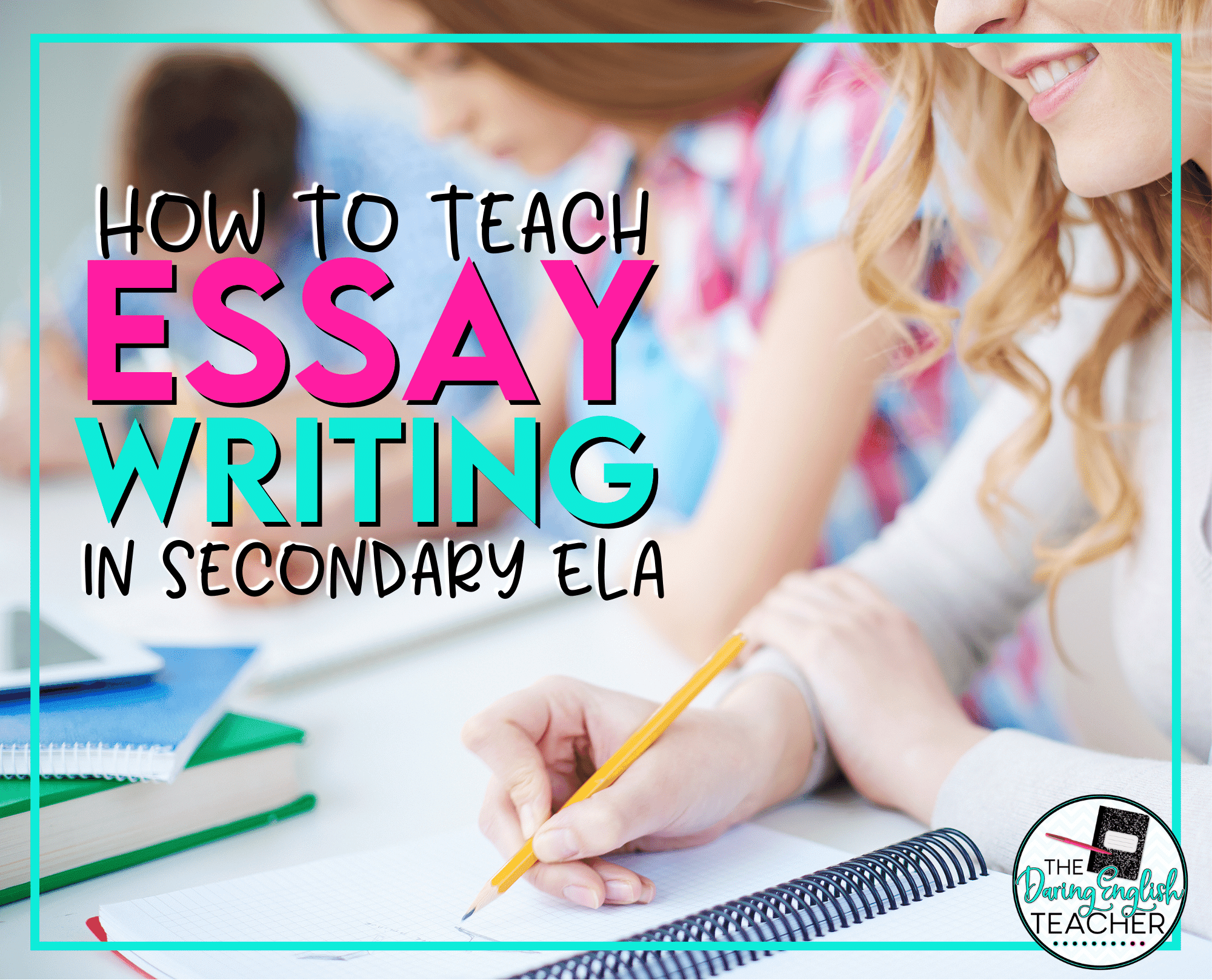
Teaching students how to write a multi-paragraph essay is a process, and it isn’t something that can be taught in one class period, nor is it a skill that we should expect our incoming students to know. Before I even assign my students a multi-paragraph essay, I first take several weeks to teach paragraph writing, and I typically do this with my short story unit.
However, once my students are ready to make the jump from paragraphs to an essay, I still continue to break down my writing instruction. When I teach essay writing in my high school English students, I break it down paragraph-by-paragraph to encourage them to be the best writer they can be. All of the lessons that I will refer to throughout this blog post are included in this print and digital essay writing teaching unit .
Teach Essay Writing in Middle School and High School ELA
Start with brainstorming.
I am a huge fan of group brainstorming, especially since I usually have some EL and SPED students mainstreamed in my college prep English classes. I usually dedicate an entire class period to brainstorming where students gather ideas, paragraph topics, and supporting quotes. You can read more about group brainstorming in this blog post where I discuss brainstorming with my students and I teach them how to brainstorm an essay.
Outline the essay
After brainstorming, I move my students to the outlining phase of the writing process. This step is essential because it helps students organize their papers and stay on topic. Ever since I started dedicating an entire class period to in-class essay outlining, I’ve noticed a significant improvement in my students’ essays. You can read more about how I teach essay outlining in this blog post . When we focus on outlining the essay, I make sure that we focus on all of the essential components of an essay: thesis statement, topic sentences, and evidence.
Write the thesis statement
After the class has completed the brainstorming and outlining, I then move on to direct instruction for essay writing. Since students have already outlined their main ideas, they can start working on their thesis statement. I use my introduction and thesis statement lesson to help students write a meaningful thesis statement. I also look at examples of good thesis statements with my students and have students turn in their draft thesis statements to me before moving on.
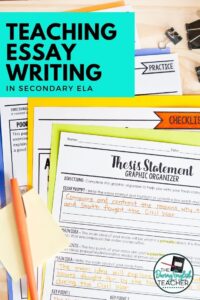
Write the introduction
Once students have a solid working thesis statement (and I say working because it is possible for it to change throughout this process), I then have them move on to the introduction. Using the same introduction and thesis writing lesson, I then have my students work on drafting a hook and background information to complete their introduction. Now that students are in high school, I don’t accept a question as an acceptable hook. However, if my students get stuck, especially some of my lower students, I have them write their questions and then help them turn them into a statement.
Also, I’ve noticed that students sometimes have a hard time jumping on the hook. They tend to get stuck there, and when this happens, I have them jump right into the background information. In doing so, students get started writing, and they can go back to the hook later.
Topic Sentences
When I complete essay outlining with my students before the drafting process, I typically have them outline each paragraph with a topic sentence and then the quotes they want to use. Once we move from the introduction to the body paragraphs, I have them work on their topic sentence first. I use my topic sentences and body paragraphs essay writing lesson with my students at this point in the essay. Once students have a good topic sentence for their body paragraph, they write the rest of their body paragraph.
Write the body paragraphs
The next step in the writing process, especially for the first essay of the school year, is for students to write out the rest of their body paragraphs. If they’ve done their outlining correctly, they have a good idea about what they want to include in their body paragraphs. In this step, I really emphasize that my students need to provide support and analysis. They should be providing more explanation than simply restating their quotes.
Write the conclusion
Once students have their introduction and body paragraphs complete, I then have them move on to writing the conclusion. At this step, I teach conclusion writing to my students and have them restate the thesis and add a general thought to the end of the paragraph. At this point, I emphasize that students should not be adding in any new information. Also, one way to help students rephrase their thesis statement is to have them rewrite it in two sentences since a thesis statement is typically a one-sentence statement.
Complete peer editing
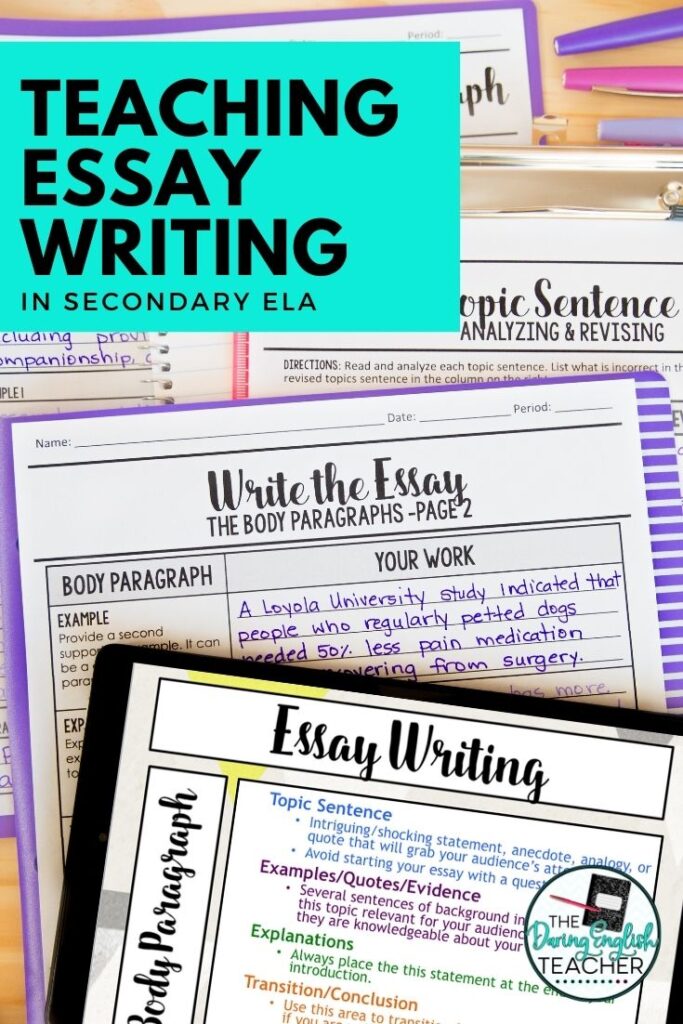
Provide time for essay revisions
Once students revise their essays and turn them in, I still like to provide students with some time to revise their essays after I grade them. This is where true learning and growth happen. It is when a student thinks they are done but then goes back to try to improve their essay. In this blog post about essay revisions , you can read more about how I conduct them in the classroom.
An entire year of writing instruction
What if I told you that you could have all of your writing instruction for the ENTIRE SCHOOL YEAR planned and ready to go? I’m talking about all the major writing strands and peer editing to grading rubrics. Just imagine how much time and stress you’ll save!
It almost sounds too good to be true, right?
It’s not! My Ultimate Writing Bundle is your one-stop shop for all of your writing instruction needs! Plus, your students will thrive with the built-in scaffolding and consistency throughout the year!
Join the Daring English Teacher community!
Subscribe to receive freebies, teaching ideas, and my latest content by email.
I won’t send you spam. Unsubscribe at any time.
Built with ConvertKit
Leave a Reply Cancel reply
Your email address will not be published. Required fields are marked *
Save my name, email, and website in this browser for the next time I comment.

SUBSCRIBE NOW

A Comprehensive High School Writing Curriculum Guide
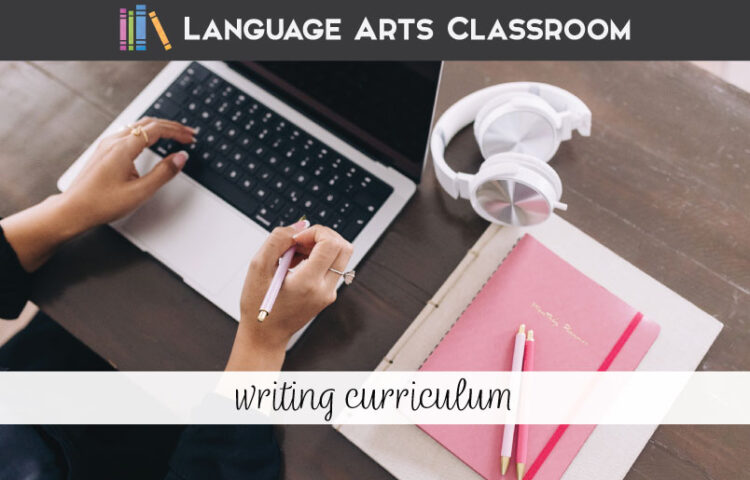
In this comprehensive high school writing curriculum guide, I explain necessary components of planning a writing for a year.
Writing is an essential skill that students need to develop in high school. Part of teaching this essential skill is encouraging, inspiring, and mentoring.
However, not all writing curriculums are created equal. A well-structured writing curriculum can help students understand the fundamentals of writing, improve their skills, and explore their creativity.

High School Writing Curriculum: A Comprehensive Guide
Honesty time: I do not suggest one entire curriculum but rather, pieces from several sources. Many tools can get you to meeting standards, encouraging young writers, and working through common struggles. However, as someone who has taught in various capacities for over twenty years, one set curriculum will probably not work. You will need to incorporate pieces of your own to address the learners in front of you and modify it each semester.
Therefore, in this blog post, I’ll explore the components, considerations, and requirements for high school students.
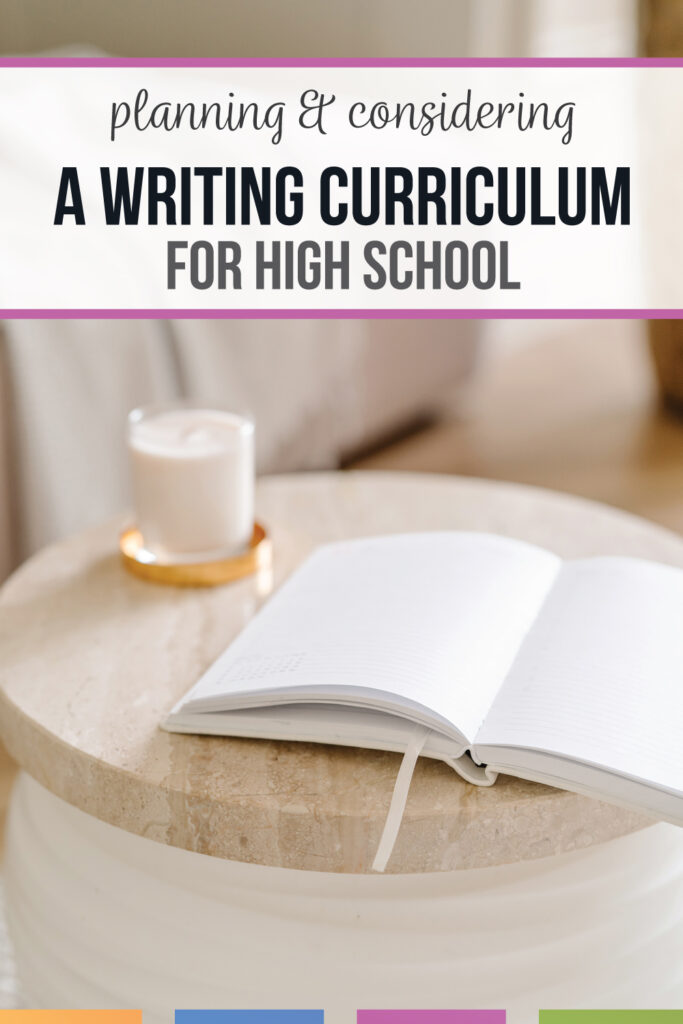
Why are you writing about a high school writing curriculum?
If you have followed me for a few years, you were with me while I finished my second master’s degree, one in English Literature . Now, I teach dual-credit writing courses at my high school in coordination with a local community college. Many of my subscribers teach a similar class for high school credit.
The previous seven years, I taught freshmen and worked with those standards. Therefore, my teaching load focuses on standards for seniors, a shift for me.
As I create and build my high school writing curriculum, these considerations come into play.
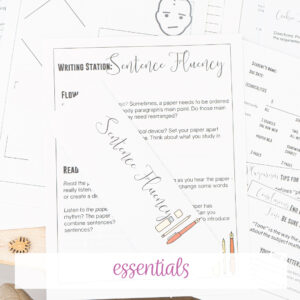
Understanding the Essentials of a High School Writing Curriculum
A comprehensive high school writing curriculum will address students’ writing skills and grammatical knowledge. Meeting language skills alongside the writing standards can happen naturally.
A well-rounded high school writing course will also address essential aspects such as argumentative writing (sometimes referenced as persuasive writing), informative, and creative/narrative writing, providing students with a holistic understanding of the writing process.
Here is my teacher’s guide to incorporate all these factors.
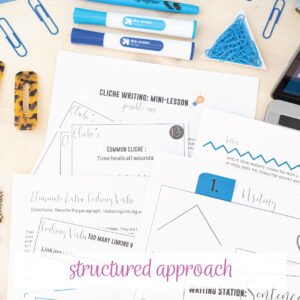
Importance of a Structured Approach to Writing
A structured approach to writing is essential in a writing curriculum. In my teaching career, I have taught several semester-long courses like public speaking, creative writing, and English 101. My #1 learned lesson: Have an overarching project that builds community in classes. For public speaking, speakers set goals for public speaking. In creative writing, writers compile a journal with writing prompts.
In a standard writing class, we use images to write about mentor sentences and fun topics . Images help young writers envision their responses, and the images work as a form of scaffolding. An ongoing activity, a habit, allows writers to reflect on their writing process, figurative language use, and sentence structure. Take time to reflect with students.
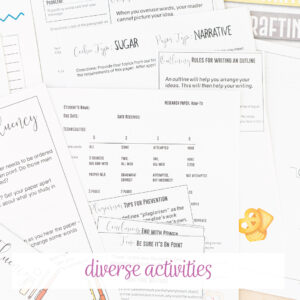
Diverse Writing Assignments
Instilling excellence in writing skills and grammar instruction is essential for an effective writing curriculum. One research paper and one narrative alongside “drill and kill” grammar will not produce an engaging high school writing curriculum.
A few of my favorite writing assignments for high school:
- Mini-memoirs (narrative standards)
- Response to informational text (an assortment of standards)
- Argumentative RAFT (argumentative standard)
- Researched famous events (expository standards)
If you look at the mentor texts (below) and provide excerpts to your classes, you will also create diverse writing assignments from those inspired pieces.
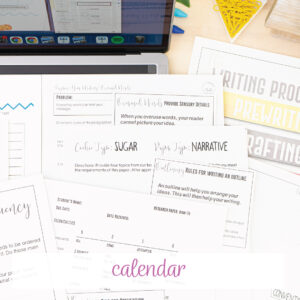
Calendar of Writing
Map out your calendar of dates. No amount of researching and organizing will help us creators of a high school writing curriculum: We must sit down with a calendar.
My high school writing curriculum contains two large-ish type assignments, one due about six weeks into the semester and another at about fourteen weeks. I space them out so that students understand my expectations and feedback, so that we have worked through our standards together, and so that large assignments are not due when students are already overwhelmed. Spacing out assignments in this manner also provides me time to provide meaningful feedback.
If you are interested in looking at my outline for a creative writing course, you can make a copy on Canva (for free).
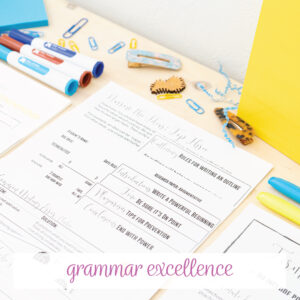
Grammar Excellence
If you have floated around my blog for a bit, you’ll realize that my preference is not to teach grammar with worksheets. A grammar workbook and worksheets have their place, sure. But once classes understand the basics of language, I branch into additional resources.
For instance, with my high school grammar activities , students use interactive pieces to practice punctuations, to add types of clauses to sentences, and to experiment with difficult concepts. The pieces allow writers to take their own writing and implement lessons. In doing so, they are experimenting with language.
Another addition to any writing program will be addressing grammatical errors . My suggestion is to assign paragraph writing and while grading, note common errors. Then, provide direct instruction and practice correcting the errors.
Any grammar curriculum will connect grammar to writing. One of my goals is to approach language in a positive way so that my brave writers feel empowered instead of crushed by grammar rules.
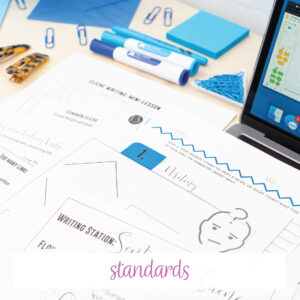
Meeting Standards with Writing
Writing standards define the expectations for what students should be able to do at each grade level. These standards aim to develop clarity, coherence, and effective communication through writing.
However, meeting these standards can sometimes be a challenge for both students and teachers. Below, I explain what helps me as my students and I work to meet writing standards.
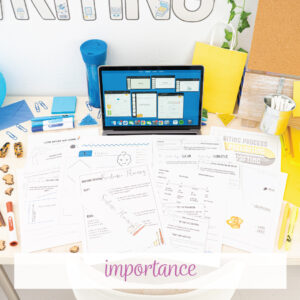
Importance of Writing Standards
Writing standards are guidelines that outline the skills and knowledge students should acquire in writing. They provide a common framework for teaching writing skills, ensuring consistency across classrooms and grade levels.
Be prepared to breakdown standards with students in sensible ways. For instance, in my creative writing activities, I break down pieces like implementing pacing and external conflicts into smaller lessons. With those smaller activities, we can dive deep into the standards.
Overall, writing standards promote clarity, coherence, and effective communication, which are essential skills in the 21st century.
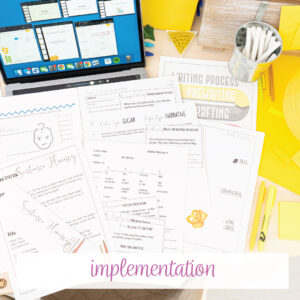
Implementation of Standards
The more you build your writing curriculum, the more engrained and natural the standards will be.
To start, align writing activities with specific standards. By doing so, you ensure that the writing skills targeted are directly tied to the standards. This alignment helps reinforce the skills and knowledge necessary for students to meet the standards effectively.
Additionally, incorporating a wide range of writing skills into lesson plans allows you to address multiple standards simultaneously, providing a comprehensive writing instruction experience for students. In the example above, pacing and external conflicts will occur in smaller activities and then implemented into larger one.
Don’t fear breaking down a standard with students. (Some teachers call this process “unpacking the standards”). The more you discuss writing expectations that derive from the standards, the more meaningful discussions you and your students will have.
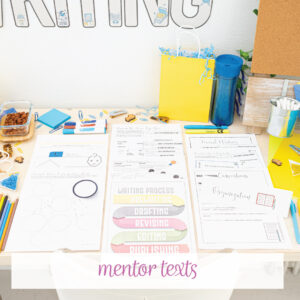
Considering mentor texts.
Mentor texts are simply example texts that work well for providing example of structure, vocabulary, language use, and any other piece of writing. Below, I have included books from which I pull pieces. Included are explanations of ways I use the excerpts.
Plus, university writing courses often use excerpts, so using them is a great way to prepare classes. If you read a publication like the New York Times, keep your eyes open to pieces you can add.
All of these affiliate links will take you to Amazon. You can read my disclosures about affiliate links.
This book might be the most loaned book from my classroom library. Dashka Slater is a journalist who wrote The 57 Bus , a story told from two perspectives of what became a hate crime.
Five Little Indians
Michelle Good’s novel portrays the lives of residential school survivors. The uses for Five Little Indians is diverse. Dialogue, setting, and pacing shine through in this story.
The Forgotten Girls
Monica Potts’ memoir weaves research into a narrative. The story covers rural women and their limited options. When older students write narratives, I encourage them to add research and use Potts’ memoir as a mentor text.
The Sun Does Shine
I’ve written about The Sun Does Shine before. Pieces from Anthony Ray Hinton’s story have been in my American literature class too. For a writing class, chapter two, “All American,” works well for modeling background and flashback.
Chapter twenty-seven, “The Symbols of Caste” works as a model for comparing two situations. Isabel Wilkerson compares America’s response to slavery to Germany’s response to the Holocaust. Her pacing and transitions serve as strong examples.
Slavery by Another Name
Douglas A. Blackmon’s book provides examples of incorporating primary sources into research. The end to the chapter, “New South Rising” has a short piece to analyze with writers.
The chapter, “Took Over the OxyContin Belt” serves as a mentor text for narrative nonfiction. From its hook to its powerful concluding paragraph, this short chapter helps me to model narratives.
Patient H.M.
Patient H. M. is about lobotomies, written by the grandson of a famous doctor who performed them decades ago. Luke Dittrich incorporates interviews into research. You can also use excerpts to model writing about delicate topics.
Excerpts from larger books provide authentic texts for young writers and if they are interested, you can loan them the book. Incorporating mentor texts into your high school writing curriculum provides young writers with inspiration and examples.
For those readers who are designing a homeschool writing curriculum, you can ask your local librarian for suggestions regarding books of varying genres.
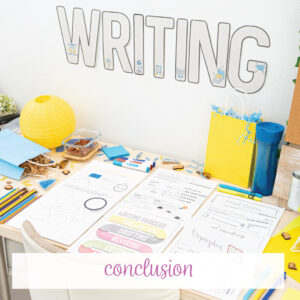
In conclusion, a high school writing curriculum should provide a structured approach to writing that covers key components such as grammar, vocabulary, and essay writing. It should also offer options that cater to different learning styles and preferences.
While most writing curriculums have their merits, it is important to incorporate creative elements to engage and inspire today’s high schoolers with your own touch. By tailoring the curriculum to your student’s needs and interests, you can make the learning experience more enjoyable and effective.
Replace a student workbook with excerpts, webinars, and audio pieces to diversity the curriculum.
Remember, the goal is to equip them with the necessary skills to express themselves confidently and effectively in various writing formats. You can see details of my high school writing curriculum as a foundation for your classes.
Would you like access to our free library of downloads?
Marketing Permissions
We will send you emails, but we will never sell your address.
You can change your mind at any time by clicking the unsubscribe link in the footer of any email you receive from us, or by contacting us at [email protected] . We will treat your information with respect. For more information about our privacy practices please visit our website. By clicking below, you agree that we may process your information in accordance with these terms.
We use Mailchimp as our marketing platform. By clicking below to subscribe, you acknowledge that your information will be transferred to Mailchimp for processing. Learn more about Mailchimp’s privacy practices.
writing writing activities writing lessons
- Share full article
Advertisement
Supported by
Writing Curriculum
Teach Narrative Writing With The New York Times
This teaching guide, part of our eight-unit writing curriculum, includes daily writing prompts, lessons based on selected mentor texts, and an invitation for students to participate in our 100-word personal narrative contest.

By The Learning Network
Stories can thrill, wound, delight, uplift and teach. Telling a story vividly and powerfully is a vital skill that is deeply valued across all cultures, past and present — and narrative writing is, of course, a key genre for literacy instruction at every level.
When your students think “New York Times,” they probably think of our 172-year history of award-winning journalism, and may not even realize that The Times today is full of personal narratives — on love and family , but also on how we relate to animals , live with disabilities or navigate anxiety . If you flip or scroll through sections of the paper, you’ll see that personal writing is everywhere, and often ranks among the most popular pieces The Times publishes each week.
At The Learning Network, we’ve been posting writing prompts every school day for over a decade now, and many of them invite personal narrative. Inspired by Times articles of all kinds, the prompts ask students to tell us about their passions and their regrets, their most embarrassing moments and their greatest achievements. Thousands of students around the world respond each month, and each week during the school year we call out our favorite responses .
In this unit we’re taking it a step further and turning our narrative-writing opportunities into a contest that invites students to tell their own stories. Below, you’ll find plenty of ideas and resources to get your students reading, writing and thinking about their own stories, including:
✔ New narrative-writing prompts every week.
✔ Daily opportunities for students to have an authentic audience for their writing via posting comments to our forums.
✔ Guided practice with mentor texts that include writing exercises.
✔ A clear, achievable end-product (our contest) modeled on real-world writing.
✔ The chance for students to have their work published in The New York Times.
Here’s how it works.
Start with personal-narrative prompts for low-stakes writing.

Related Article | Related Picture Prompt
Every week during the school year we publish new narrative writing prompts on a vast array of topics via our Student Opinion and Picture Prompts columns. These prompts can be a starting point to help your students start reflecting on their lives and the stories they have to tell.
Each prompt is inspired by a Times article, which is free if you access it through our site, and all are open for comment for students 13 and up. Every comment is read by Learning Network editors before it is approved.
Teachers have told us they use our prompts as an opportunity for daily writing practice, a communal space where students can practice honing voice, trying new techniques and writing for a real audience. And if students are writing formal personal narrative essays, whether for college applications, for our contest or for any other reason, our prompts might serve as inspiration to help them find topics.
Student Opinion Questions
We publish a new Student Opinion question every school day, including many that invite personal writing. Students will read a related Times article and then respond to questions that help them think about how it applies to their own lives, like these:
“ What Cultural Traditions Are Important to You? ” “ Has Forgiving Someone Ever Made You Feel Better? ” “ How Do You Get Over Rejection? ”
You can find them all, as they publish, here . Or check out our collection of 445 Prompts for Narrative and Personal Writing for years-worth of evergreen questions, organized into categories like family, school, personality and childhood memories.
Picture Prompts
These accessible, image-driven prompts inspire a variety of kinds of writing and we publish them Tuesday through Friday during the school year. Each week we post at least one prompt that asks students to share experiences from their lives, such as this one that invites students to write about memories of their childhood homes , and one that asks them to tell a story about a moment from their lives inspired by an image, such as this one .
You can find all of our Picture Prompts, as they publish, here . At the end of each school year, we round them all up and categorize them by genre of writing. Take a look at our collections from 2017 , 2018 , 2019 , 2020 , 2021 , 2022 and 2023 and scroll down to look for the categories like “What story does this image inspire for you?” and “Share experiences from your own life” to find many prompts that can inspire narratives.
A special “rehearsal space” for teenagers to experiment writing 100-word narratives.
To help with our Tiny Memoir contest, we posted a student forum last year asking, “ What Story From Your Life Can You Tell in 100 Words? ” In it, we lead students through a few questions, and provide a few examples, to show them how. It is still open for comment. We hope that as they search for topics and try out techniques, students will post their drafts here for others to read and comment on.
Read mentor texts and try some of the “writer’s moves” we spotlight.
The Times is full of wonderful writing that can serve as mentor texts for helping students look at the various elements of the genre and think about how to weave specific craft moves into their own writing. We have a couple of ways students can use them for narrative writing.
Mentor Texts Lessons
For our 2023 Tiny Memoir Contest for Students, in which students are invited to describe a meaningful true moment from their lives in 100 words or fewer, we have a set of mentor texts, all of which can be found in our step-by-step guide: How to Write a 100-Word Narrative: A Guide for Our Tiny Memoir Contest . The 25 texts we use can also be found in this PDF .
During the years when we ran a Personal Narrative Contest that allowed students 600 words to tell a story, we broke narrative writing into several key elements and spotlighted a mentor text that does a particularly good job at each. All of them are still applicable to our new contest, which spotlights the same qualities, just in miniature. They have also been woven in to our step-by-step guide :
Tell a story about a small but memorable event or moment in your life.
Use details to show, not tell.
Write from your own point of view, in your real voice.
Use dialogue effectively.
Drop the reader into a scene.
Tell a complete story, with a true narrative arc.
Reflect on the experience and give the reader a take-away.
After students read each of the mentor texts on this list and focus on a specific technique, we invite them to “Now Try This” via an exercise that helps them practice that element. Then, we provide additional mentor text examples, as well as a list of questions to consider while reading any of them. The goal is to demystify what good writing looks like, and encourage students to practice concrete exercises to use those techniques.
Annotated by the Author
But our favorite mentor texts to assign? The work of the teenage winners of our narrative contests. Here are the 2019 , 2020 and 2021 collections of our Personal Narrative Contest. And here are the winners of our first-ever 100-Word Narrative Contest . Which of these pieces do your students like best? What “writer’s moves” might they emulate in their own work?
We also invited three teenagers who won our 2019 contest to annotate their winning narratives for our “Annotated by the Author” series. In these pieces, they demystify their writing process and share ideas other students can try in their own essays.
Annotated by the Author: ‘Speechless’
Annotated by the Author: ‘Pants on Fire’
Annotated by the Author: ‘Cracks in the Pavement’
In addition, we have a piece annotated by the college-aged author of a winning Modern Love piece. In Annotated by the Author: ‘Why Can’t Men Say “I Love You” to Each Other?’ Ricardo F. Jaramillo tells us how to make your reader want to keep reading, how to balance scenes and ideas, why you can’t write a personal essay without “looking inside,” and much more.
Enter our “ Tiny Memoir” Personal Narrative Essay Contest .
At this point in the unit, your students will have practiced writing about their lives using our many prompts. They will also have read several mentor texts, and practiced elements of personal writing with each one. Now, we hope, they can produce a polished piece of writing that brings it all together.
For three years, we ran a personal narrative contest that asked for a “short, powerful story about a meaningful life experience” in 600 words or less. But last year, we debuted our Tiny Memoir Contest that challenged students to tell us a story from their lives in just 100 words. The results blew us away. Teachers told us it was one of the most engaging assignments they gave all year and that the word limit made students’ writing much more focused and powerful. So this year, we’re running it again. We hope this contest will be fun for your students, and a useful exercise if they are going on to write longer pieces, such as a college essay.
Beyond a caution to write no more than 100 words, our contest is fairly open-ended. We’re not asking students to write to a particular theme or use a specific structure or style; instead, we encourage them to experiment and produce something that they feel represents their real voice, telling a tale that matters to them.
All student work will be read by Times editors or journalists and/or by educators from around the country. Winners will have their work published on our site and, perhaps, in the print New York Times.
Though our 100-word contest is slightly different than the original, we still recommend that before students submit, they watch this two-minute video in which student winners from past years share advice on the writing, editing and submission process. Ask students:
What techniques did these students employ that helped make their entries successful?
What did these students gain from having entered this contest? What were some of the challenges they encountered?
What advice can your students use as they work on their own submissions?
This contest will run from Oct. 4 to Nov. 1, 2023. We will link the official announcement here when it publishes, but in the meantime, here are last year’s rules and guidelines , which will remain largely the same.
Additional Resources
While the core of our unit is the prompts, mentor texts and contest, we also offer additional resources to inspire and support teachers, including lesson plans and great ideas from our readers around personal narrative writing.
Lesson Plans
“ From ‘Lives’ to ‘Modern Love’: Writing Personal Essays With Help From The New York Times ”
“ I Remember: Teaching About the Role of Memory Across the Curriculum ”
“ Creative State of Mind: Focusing on the Writing Process ”
“ Writing Narratives With ‘Tiny Love Stories’ ”
“ Telling Short, Memorable Stories With Metropolitan Diary ”
Reader Ideas
“ Flipping the Script on the College Essay With Help From The New York Times ”
“ Teaching Great Writing One Sentence at a Time ”
“ Using the Modern Love Podcast to Teach Narrative Writing ”
“ Fostering Selfhood and Inspiring Student Writers Using ‘Metropolitan Diary’ ”
Teaching Narrative Writing With The New York Times (On-Demand)
Personal Narratives From the Newsroom to the Classroom (On-Demand)
Have a language expert improve your writing
Run a free plagiarism check in 10 minutes, generate accurate citations for free.
- Knowledge Base
The Beginner's Guide to Writing an Essay | Steps & Examples
An academic essay is a focused piece of writing that develops an idea or argument using evidence, analysis, and interpretation.
There are many types of essays you might write as a student. The content and length of an essay depends on your level, subject of study, and course requirements. However, most essays at university level are argumentative — they aim to persuade the reader of a particular position or perspective on a topic.
The essay writing process consists of three main stages:
- Preparation: Decide on your topic, do your research, and create an essay outline.
- Writing : Set out your argument in the introduction, develop it with evidence in the main body, and wrap it up with a conclusion.
- Revision: Check your essay on the content, organization, grammar, spelling, and formatting of your essay.
Instantly correct all language mistakes in your text
Upload your document to correct all your mistakes in minutes

Table of contents
Essay writing process, preparation for writing an essay, writing the introduction, writing the main body, writing the conclusion, essay checklist, lecture slides, frequently asked questions about writing an essay.
The writing process of preparation, writing, and revisions applies to every essay or paper, but the time and effort spent on each stage depends on the type of essay .
For example, if you’ve been assigned a five-paragraph expository essay for a high school class, you’ll probably spend the most time on the writing stage; for a college-level argumentative essay , on the other hand, you’ll need to spend more time researching your topic and developing an original argument before you start writing.
Here's why students love Scribbr's proofreading services
Discover proofreading & editing
Before you start writing, you should make sure you have a clear idea of what you want to say and how you’re going to say it. There are a few key steps you can follow to make sure you’re prepared:
- Understand your assignment: What is the goal of this essay? What is the length and deadline of the assignment? Is there anything you need to clarify with your teacher or professor?
- Define a topic: If you’re allowed to choose your own topic , try to pick something that you already know a bit about and that will hold your interest.
- Do your research: Read primary and secondary sources and take notes to help you work out your position and angle on the topic. You’ll use these as evidence for your points.
- Come up with a thesis: The thesis is the central point or argument that you want to make. A clear thesis is essential for a focused essay—you should keep referring back to it as you write.
- Create an outline: Map out the rough structure of your essay in an outline . This makes it easier to start writing and keeps you on track as you go.
Once you’ve got a clear idea of what you want to discuss, in what order, and what evidence you’ll use, you’re ready to start writing.
The introduction sets the tone for your essay. It should grab the reader’s interest and inform them of what to expect. The introduction generally comprises 10–20% of the text.
1. Hook your reader
The first sentence of the introduction should pique your reader’s interest and curiosity. This sentence is sometimes called the hook. It might be an intriguing question, a surprising fact, or a bold statement emphasizing the relevance of the topic.
Let’s say we’re writing an essay about the development of Braille (the raised-dot reading and writing system used by visually impaired people). Our hook can make a strong statement about the topic:
The invention of Braille was a major turning point in the history of disability.
2. Provide background on your topic
Next, it’s important to give context that will help your reader understand your argument. This might involve providing background information, giving an overview of important academic work or debates on the topic, and explaining difficult terms. Don’t provide too much detail in the introduction—you can elaborate in the body of your essay.
3. Present the thesis statement
Next, you should formulate your thesis statement— the central argument you’re going to make. The thesis statement provides focus and signals your position on the topic. It is usually one or two sentences long. The thesis statement for our essay on Braille could look like this:
As the first writing system designed for blind people’s needs, Braille was a groundbreaking new accessibility tool. It not only provided practical benefits, but also helped change the cultural status of blindness.
4. Map the structure
In longer essays, you can end the introduction by briefly describing what will be covered in each part of the essay. This guides the reader through your structure and gives a preview of how your argument will develop.
The invention of Braille marked a major turning point in the history of disability. The writing system of raised dots used by blind and visually impaired people was developed by Louis Braille in nineteenth-century France. In a society that did not value disabled people in general, blindness was particularly stigmatized, and lack of access to reading and writing was a significant barrier to social participation. The idea of tactile reading was not entirely new, but existing methods based on sighted systems were difficult to learn and use. As the first writing system designed for blind people’s needs, Braille was a groundbreaking new accessibility tool. It not only provided practical benefits, but also helped change the cultural status of blindness. This essay begins by discussing the situation of blind people in nineteenth-century Europe. It then describes the invention of Braille and the gradual process of its acceptance within blind education. Subsequently, it explores the wide-ranging effects of this invention on blind people’s social and cultural lives.
Write your essay introduction
The body of your essay is where you make arguments supporting your thesis, provide evidence, and develop your ideas. Its purpose is to present, interpret, and analyze the information and sources you have gathered to support your argument.
Length of the body text
The length of the body depends on the type of essay. On average, the body comprises 60–80% of your essay. For a high school essay, this could be just three paragraphs, but for a graduate school essay of 6,000 words, the body could take up 8–10 pages.
Paragraph structure
To give your essay a clear structure , it is important to organize it into paragraphs . Each paragraph should be centered around one main point or idea.
That idea is introduced in a topic sentence . The topic sentence should generally lead on from the previous paragraph and introduce the point to be made in this paragraph. Transition words can be used to create clear connections between sentences.
After the topic sentence, present evidence such as data, examples, or quotes from relevant sources. Be sure to interpret and explain the evidence, and show how it helps develop your overall argument.
Lack of access to reading and writing put blind people at a serious disadvantage in nineteenth-century society. Text was one of the primary methods through which people engaged with culture, communicated with others, and accessed information; without a well-developed reading system that did not rely on sight, blind people were excluded from social participation (Weygand, 2009). While disabled people in general suffered from discrimination, blindness was widely viewed as the worst disability, and it was commonly believed that blind people were incapable of pursuing a profession or improving themselves through culture (Weygand, 2009). This demonstrates the importance of reading and writing to social status at the time: without access to text, it was considered impossible to fully participate in society. Blind people were excluded from the sighted world, but also entirely dependent on sighted people for information and education.
See the full essay example
The conclusion is the final paragraph of an essay. It should generally take up no more than 10–15% of the text . A strong essay conclusion :
- Returns to your thesis
- Ties together your main points
- Shows why your argument matters
A great conclusion should finish with a memorable or impactful sentence that leaves the reader with a strong final impression.
What not to include in a conclusion
To make your essay’s conclusion as strong as possible, there are a few things you should avoid. The most common mistakes are:
- Including new arguments or evidence
- Undermining your arguments (e.g. “This is just one approach of many”)
- Using concluding phrases like “To sum up…” or “In conclusion…”
Braille paved the way for dramatic cultural changes in the way blind people were treated and the opportunities available to them. Louis Braille’s innovation was to reimagine existing reading systems from a blind perspective, and the success of this invention required sighted teachers to adapt to their students’ reality instead of the other way around. In this sense, Braille helped drive broader social changes in the status of blindness. New accessibility tools provide practical advantages to those who need them, but they can also change the perspectives and attitudes of those who do not.
Write your essay conclusion
Checklist: Essay
My essay follows the requirements of the assignment (topic and length ).
My introduction sparks the reader’s interest and provides any necessary background information on the topic.
My introduction contains a thesis statement that states the focus and position of the essay.
I use paragraphs to structure the essay.
I use topic sentences to introduce each paragraph.
Each paragraph has a single focus and a clear connection to the thesis statement.
I make clear transitions between paragraphs and ideas.
My conclusion doesn’t just repeat my points, but draws connections between arguments.
I don’t introduce new arguments or evidence in the conclusion.
I have given an in-text citation for every quote or piece of information I got from another source.
I have included a reference page at the end of my essay, listing full details of all my sources.
My citations and references are correctly formatted according to the required citation style .
My essay has an interesting and informative title.
I have followed all formatting guidelines (e.g. font, page numbers, line spacing).
Your essay meets all the most important requirements. Our editors can give it a final check to help you submit with confidence.
Open Google Slides Download PowerPoint
An essay is a focused piece of writing that explains, argues, describes, or narrates.
In high school, you may have to write many different types of essays to develop your writing skills.
Academic essays at college level are usually argumentative : you develop a clear thesis about your topic and make a case for your position using evidence, analysis and interpretation.
The structure of an essay is divided into an introduction that presents your topic and thesis statement , a body containing your in-depth analysis and arguments, and a conclusion wrapping up your ideas.
The structure of the body is flexible, but you should always spend some time thinking about how you can organize your essay to best serve your ideas.
Your essay introduction should include three main things, in this order:
- An opening hook to catch the reader’s attention.
- Relevant background information that the reader needs to know.
- A thesis statement that presents your main point or argument.
The length of each part depends on the length and complexity of your essay .
A thesis statement is a sentence that sums up the central point of your paper or essay . Everything else you write should relate to this key idea.
The thesis statement is essential in any academic essay or research paper for two main reasons:
- It gives your writing direction and focus.
- It gives the reader a concise summary of your main point.
Without a clear thesis statement, an essay can end up rambling and unfocused, leaving your reader unsure of exactly what you want to say.
A topic sentence is a sentence that expresses the main point of a paragraph . Everything else in the paragraph should relate to the topic sentence.
At college level, you must properly cite your sources in all essays , research papers , and other academic texts (except exams and in-class exercises).
Add a citation whenever you quote , paraphrase , or summarize information or ideas from a source. You should also give full source details in a bibliography or reference list at the end of your text.
The exact format of your citations depends on which citation style you are instructed to use. The most common styles are APA , MLA , and Chicago .
Is this article helpful?
Other students also liked.
- How long is an essay? Guidelines for different types of essay
- How to write an essay introduction | 4 steps & examples
- How to conclude an essay | Interactive example
More interesting articles
- Checklist for academic essays | Is your essay ready to submit?
- Comparing and contrasting in an essay | Tips & examples
- Example of a great essay | Explanations, tips & tricks
- Generate topic ideas for an essay or paper | Tips & techniques
- How to revise an essay in 3 simple steps
- How to structure an essay: Templates and tips
- How to write a descriptive essay | Example & tips
- How to write a literary analysis essay | A step-by-step guide
- How to write a narrative essay | Example & tips
- How to write a rhetorical analysis | Key concepts & examples
- How to Write a Thesis Statement | 4 Steps & Examples
- How to write an argumentative essay | Examples & tips
- How to write an essay outline | Guidelines & examples
- How to write an expository essay
- How to write the body of an essay | Drafting & redrafting
- Kinds of argumentative academic essays and their purposes
- Organizational tips for academic essays
- The four main types of essay | Quick guide with examples
- Transition sentences | Tips & examples for clear writing
What is your plagiarism score?
- Our Mission
Essay Assignments That Actually Engage High School Writers
Cookie-cutter essays may reflect students’ attitude toward the assignment, not their writing ability. Here’s a way to make that stack of grading more rewarding.

Have you ever been three papers into reading a stack of essays and realized that they were all pretty much the same? Years ago, after reading the 100th cookie-cutter essay on characterization in Of Mice and Men , I realized that the agonizingly boring essays were not really my students’ fault—they were the predictable result of the assignment that I had given them. Ever since then, I’ve striven to prepare students to produce writing that I truly enjoy reading. It took me some time and experimentation, but here are the keys I’ve discovered to getting students engaged and creating writing that is a joy to read.
Connecting Readings to Students’ Lives
After 25 years of teaching, I’m still having epiphanies about how to engage students. One such realization is that if I want students to dig into anything I’m teaching in my classroom, I must find a way to help them connect it to something else they already know or care about.
It was my husband, Joe, a history instructor at a local community college, who helped me realize this with an assignment he gives, aptly named the Connections Paper. He gives students a handful of documents, both primary and secondary, and asks them to discuss how the documents relate to each other, how the documents help them make sense of the past, and how the documents help them make sense of the present.
This deceptively simple task prompts students to connect seemingly distant events to their own world and gives these events richer dimension and meaning. I became determined to replicate this connection with my students in my high school English classes.
Providing Real-Life Models and Choices
In Writing With Mentors , Allison Marchetti and Rebekah O’Dell detail how to use “the work of real writers and the real reading you do every day” to support student writing. One of the projects that excites my students the most is our podcast unit , and one reason it works so well is that students use writing produced for real audiences—not just their teacher—to guide their own writing about a topic of their choice.
The mentor text method consists of students breaking down the structure and techniques used by the writer in a particular piece of writing, and employing some of what they find to create their own original pieces. Although we use podcast scripts in this particular assignment, this method has possibilities limited only by the mentor texts you can find. From résumés to lab reports to poetry to video game reviews, students can learn to write anything, and the fact that they are using writing produced by people outside of classrooms is incredibly engaging for them—and for teachers as well.
Another reason mentor texts are so engaging and effective is that they provide students with choices in how they will develop their writing—they can choose which of the writer’s moves to use in their own writing. After sharing and analyzing some carefully selected podcasts with my students, I encourage them to bring in ones that tie into subjects that they are particularly interested in. They not only learn more techniques for creating their podcast but also see the diversity of topics and formats that current podcasters use.

Finding Different Approaches to the Research Paper
There are many other ways to build choice into writing, and I use some of them in my Education Synthesis paper with my American Literature students. We begin with an essential question: What is the purpose of education, and how well is the U.S. fulfilling that purpose? Students read several pieces of writing that touch on that topic and take notes on anything they notice that answers the question.
Some of the texts I’ve used in the past include essays, short stories, poetry, videos, comics, and articles:
- “School Is Hell” cartoons by Matt Groenig
- “Superman and Me,” an essay by Sherman Alexie
- “Changing Educational Paradigms,” a TED talk by Sir Ken Robinson
- “The Bees,” a poem by Audre Lorde
- “Learning Like a Jungle Tiger,” a video by Trevor Ragan
- “Shoulders,” a poem by Naomi Shihab Nye
- “On Listening to Your Teacher Take Attendance,” a poem by Aimee Nezhukumatathil
- “Me Talk Pretty One Day,” an essay by David Sedaris
- “A Talk to Teachers,” a speech by James Baldwin
- “James Baldwin’s Lesson for Teachers in a Time of Turmoil,” an article by Clint Smith
After reading the texts I provide with the essential question in mind, students begin to formulate an answer, which will become the claim in their argumentative essay. They then branch out on their own, seeking more research to support their argument, and occasionally adjusting their claim as they discover more evidence.
The instructions for the final paper are simple. It must include:
- a thesis in the introduction that answers the essential question: What is wrong with our educational system, and what changes can we make to improve it?,
- evidence in the body paragraphs to support their claim from multiple sources, including the ones we read as a class and ones they found on their own, and
- students’ own commentary explaining how the evidence supports their argumentative claim.
The resulting papers are refreshingly full of students’ own ideas and reasoning and free of the stilted repetition of facts, summaries, and half-page quotes that I used to dread when collecting essays. When given the opportunity to make real-life connections and choose what they will write about, my students astound me with their engagement in and ownership of the writing process, and reading their work is now a whole lot more rewarding.
- International
- Topical and themed
- Early years
- Special needs
- Schools directory
- Resources Jobs Schools directory News Search
Developing essay-writing skills at secondary
Australia and new zealand, international schools, whole school, tes resources team.

Take students through the steps to effective essay writing in any subject with these skills lessons and supporting tools
Most students have a love-hate relationship with essay writing. They recognise that it’s one of the best vehicles through which to demonstrate their understanding of a particular topic or subject area, but crafting an essay can take a long time.
Why not make the prospect less daunting with this collection of hand-picked lesson ideas? We’ve also chosen some top tools to help learners to develop their skills, and their confidence, at each stage of the essay-writing process.
Essay writing guides

Essay Writing Toolkit

Discursive Essay Writing for GCSE: Revision Sheet

How to write an essay
Sentence starters and vocab mats.

Three tense GCSE Spanish writing mat (w/irregulars and opinions)
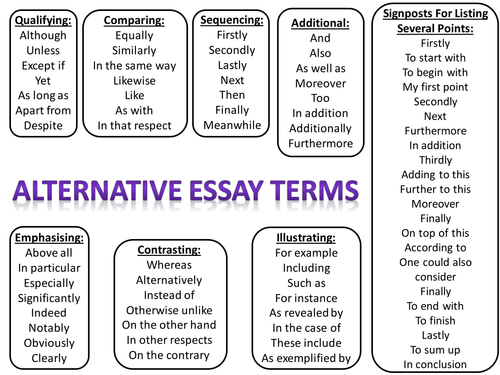
Sentence openers - analyitical & essay writing

AQA English Language and Literature Structure Strips
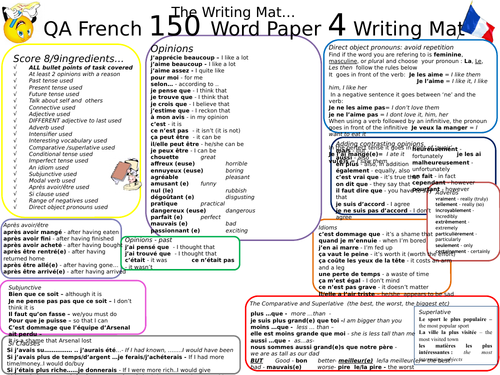
GCSE AQA New Spec French Writing Mat - 150 Word

@AllRoundRes ULTIMATE PEEL Paragraph Guide! + Planning Pages!
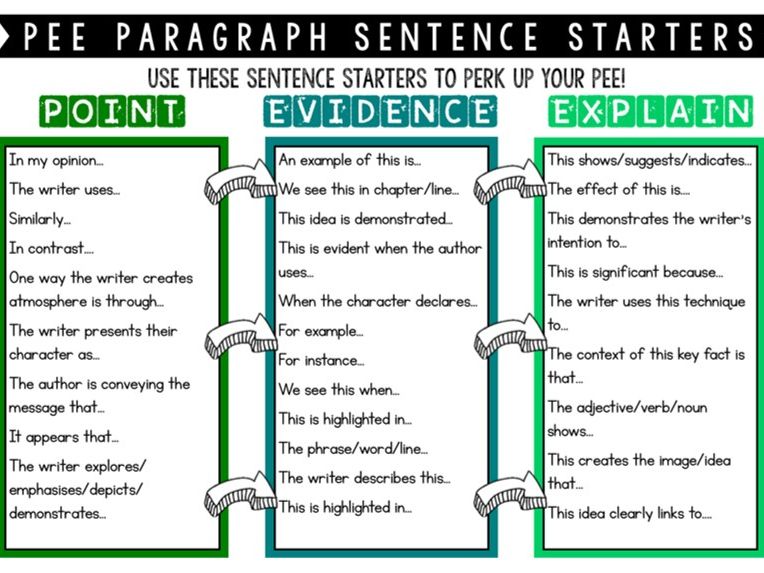
PEE Paragraph Sentence Starters
Classroom displays and student handouts.

Writing Purposes - Helpsheets/Posters for Literacy and English

Paragraph Writing: Structure Strips for GCSE English Literature (AQA)

FREE Signposting Posters for Classroom Display

What/How/Why Display Resource

Analytical Verbs Wall Display
Essay Writing Tips and Resources for Junior & High School Students
- Haley Drucker
- Categories : Help with writing assignments paragraphs, essays, outlines & more
- Tags : Homework help & study guides
Essay Writing as a Skill
Students sometimes see essay writing as something you are either good at or you aren’t. This is a mistake, and leads to a lack of effort and a lot of essays that don’t live up to their potential. Writing a good essay is a skill, one that can be practiced and improved upon. With these essay writing tips and the resources linked to in the sections below, students can learn to start producing papers they can be proud of.
Brainstorming and Preparation
Picking a Topic: A good essay starts long before any actual writing happens. The first thing you’ll need to do is select a topic. Good essay topics take careful thought—don’t just decide to write about the first thing that comes to mind. One guideline to remember is that, in general, the narrower your topic is the better. A specific, restricted topic helps you keep your essay organized and focused. It’s also best to choose a topic you find interesting—even in the most boring of subjects or books there’s likely to be one aspect that interests you on some level.
Doing Research: Depending on the type of essay, the next step may be to do some research. Be sure to allocate plenty of time for this very important task. Use as many different kinds of materials as possible—from websites to books to documentaries—and keep an eye out for themes and ideas that keep popping up. These are the kinds of things that should probably make an appearance in your essay. And don’t forget to take notes during the research process, so you’ll be able to find the information and quotes you need later on.
Outlining: Then you’re ready to starting outlining your essay. This can be as specific or as general as you want, but it’s best to approach each essay with a plan in mind rather than writing it from scratch. If you at least have an idea of what main ideas you are going to cover and in what order, you’ll take a lot of stress out of the actual writing process. Graphic organizers such as mind maps and Venn diagrams can really help you get your ideas in order and make sense of all your notes and information.
Types of Essays
The other thing you’ll want to do before you start writing is consider the essay’s genre. Each type of essay has its own rules and conventions. You don’t want to finish the conclusion just to realize that your persuasive essay has somehow turned into a research paper. These are a few of the essay writing genres most commonly assigned:
Research Papers: A research paper is meant to educate the reader about something, so this type of essay is the one that requires the most research. It should also be very formal, and should include plenty of quotes and citations.
Persuasive Essays : The whole point of this kind of paper is to convince your audience to agree with you about something. Everything you write, every fact and quote you use, should be focused on strengthening your argument and the persuasive power of your essay.
Literary Analysis: These essays are about a particular book or other text, but this isn’t a book report. You’ll want to summarize the book briefly, but the bulk of the paper needs to be about analyzing and interpreting it (or certain aspects like a particular character or theme).
Compare and Contrast Essays: This is pretty straightforward—in this type of essay you’ll need to compare and contrast two or more things (books, time periods, countries, paintings, etc). The most common issue students have with these papers is focusing too much on comparing and forgetting to contrast, or vice versa.
Reflective Essays : Also called personal essays or narrative essays, these papers are about your personal experiences. They will be structured more like a story, and so won’t follow the usual five-paragraph format. Also, this is the only kind of essay you probably won’t need to do any research for.
Writing the Essay
It’s finally time to start writing the first draft. Don’t worry about editing at this point, or about getting everything perfect. It’s best to just write a full first draft, then go back to revise it and make sure it sounds smooth and is well-organized. It can even help to skip the introduction and go straight to the body paragraphs , then come back and write the introduction at the end. After all, you won’t be completely sure what your paper is about until it’s actually written. Make sure to be familiar with the five-paragraph essay format as many teachers require you to write this way, and even if they don’t, it provides a helpful structure to follow.
Your most powerful tools for keeping yourself organized and focused during the essay writing process are your thesis and topic sentences. The thesis statement can usually be found at the end of the first paragraph, and provides a general guideline for what you’re going to discuss throughout the essay. Each body paragraph should then start with a topic sentence , which is like a mini thesis that provides an outline for just that paragraph. Everything in a paragraph should relate back to its topic sentence, and every topic sentence should relate back to the thesis statement. This keeps you from rambling and makes your essay easier to read (and grade).
Intros and Conclusions
These two parts of your paper deserve a special mention for two reasons. Many students find these paragraphs the hardest to write, and at the same time they are arguably the two most important paragraphs. After all, the introduction and conclusion are the first and last parts of your writing the teacher will see, and so are very influential on their impressions about your essay.
Introductions : The most crucial part of the intro paragraph is the last sentence or two, which constitutes the thesis statement (see above). But what about the rest of the paragraph? A good strategy is to start general and narrow down into your specific topic. For example, you might start by mentioning the tragic effects of war in general, and then move into discussing WWII is particular. It can also help draw reader interest to start the introduction with a quote, question, brief story, or personal experience (avoid starting with a dictionary definition though—that tactic is overused and not terribly professional).
Conclusions : It’s a good idea to devote the first few sentences of the conclusion to giving a brief summary of what you’ve discussed in your essay—in short, to restating your thesis statement. But you don’t want to just summarize in your conclusion. That’s redundant, and not very interesting. Instead, use the second half of the conclusion to answer the questions “So what?” and “Who cares?” Consider relating your paper to a current event or important issue, introducing an interesting question for the reader to ponder, or providing a call to action.
Revising and Proofreading
A lot of students skip over these steps. But a first draft hardly ever makes for a good essay. You’ll need to go though and tighten the focus and organization, improve the grammar and sentence structures, and scan for typos and mistakes. Editing is a part of essay writing, not something separate or less important.
Good editing takes place in two steps. First is the revision stage, where you pay attention to the large-scale issues. This is where you add and delete sentences, move paragraphs, and rewrite or delete anything that isn’t working or distracts from your thesis. Make sure every paragraph addresses a single idea, and that idea is reflected in the topic sentence. Check your thesis statement—does it accurately reflect what your paper is about? During this stage you’ll also want to pay attention to how the paper sounds. Does it flow well? Are there transitions? Are all the sentences too long or too short, or is there a good variety? And consider the format of your paper—does it look professional?
Then, when you’re happy with the paper as a whole, you can begin to proofread. This involves editing for good grammar and spelling, eliminating unnecessary words , and checking facts, page numbers, and quotes to make sure they’re accurate. This reason you should do this last is that, if you don’t, you might spend a lot of time fixing the grammar in a sentence only to realize later that sentence needs to be deleted because it’s off topic. And remember not to rely on Microsoft to do these tasks for you—spell check doesn’t catch everything, and grammar check is just plain wrong at least half the time.
Avoiding Perfectionism
No essay will ever be perfect. All the same, essay writing can be a frustrating task because it’s hard to figure out exactly when you’ve finished. Put plenty of time and effort into your paper, but don’t stress yourself out by trying to write the world’s best essay. A good rule of thumb is that when you start changing things back to the way they were in your previous revision, you should probably stop and call the essay complete. Writing doesn’t have to be a stressful process, after all—and these essay writing tips will hopefully go a long way towards making it an easy and maybe even a fun process.
Teaching Essay Writing - Where do I start?

The Write Foundation is a tried and proven homeschool writing curriculum that lays a solid writing foundation and develops competent, confident writers, even with students who were clueless on how to write. Students learn organizational groundwork for writing simple paragraphs and then advance to college level essays. With a variety of topics and types of paragraphs this curriculum guides you as you teach how to logically and easily write formal papers that “Wow!” professors.
Every lesson in TWF is arranged with detailed, specific guidelines, and gives you the necessary tools to teach the lessons and assist students while they complete their independent work. The Write Foundation provides detailed lesson plans for you to easily follow.
- Daily Schedules : every lesson divided into instruction groups.
- Teacher Presentation : pages for you to use when presenting the lesson (included in the instruction manual and separately in digital format to be used to fit your situation)
- Student Worksheets : 1 set is provided with each level of instruction.Pages which guide students both during the lesson and their independent work. Student Assignments: extra instruction and reminders to guide students as they complete their independent work. Checklists for students to use to edit their work.
The instruction manuals provide:
- Step-by-step teaching instruction for you to follow.
- Examples of possible correct answers.
- Example brainstorms, outlines and paragraphs.
Additional Resources are also sent to you with the following and more:
- Games: instructions for 1 or more students
- Grading Checklists: to help you grade their work.
- Grading System: if you need help with record keeping.
When a student is working on the correct level, intensive teacher instruction drops significantly as the year progresses.
- Students understand and retain more when they work at a level where learning comes easily for them.
- Some students need more teacher help for a while, but many others become more independent quickly.
- Students gain independence as good writing habits are solidified and they are on their way to becoming independent proficient writers.
Mom’s work load is determined by placing students on the right level. Try the free sample lessons before you purchase the curriculum to help determine which level is right for your students.
Entry Level Creating Sentences: Students use fun educational games and activities, while learning to compose and develop sentences by putting words and phrases together like pieces in a puzzle. Students will not be asking, “But what do I write about?”
Sentence to Paragraph Level 1 : Students learn to write better sentences, which describe and inform, while they learn the core basics of writing simple paragraphs using the writing process.
Paragraph Writing Level 2 : Students continue to develop their sentence and paragraph writing skills using the writing process, while advancing to multi-paragraph formal writing.
Essay Writing Level 3 : Students fine tune and develop mature writing skills, so they can easily write a well organized multi-paragraph college level essay that “Wows!” everyone.
See Suggested Age Levels for Homeschool Writing for more specific guidelines for each level.
Questions or Comments?
Recent articles.
- Correcting Run-on Sentences
- How Does Skipping the Writing Process Affect your Writing?
- Graduating Homeschooling
- Is My Child Ready for Formal Writing?
- Teaching Spelling
- Evaluating Homeschool Writing Curriculums
- How to Teach Essay Writing
- Why Most Writing Curriculums Fail (and How to Make Sure your Homeschooler Doesn't!)
- Top Five Reasons Students Hate to Write (and How You can Help!)
- College Preparation for Homeschooled Students
H e is like a man building a house, who dug deep and laid the foundation on the rock. Luke 6:48

View, Print, and Practice the Sample Lessons
(We're here to help you teach!)
Now Available!
Free Reading Lists Get your copy today!
Have a struggling writer? Maybe he hates writing? Does your student just need to learn how to write? Long for teacher-friendly lesson plans you can quickly prepare and teach? Desire a writing curriculum your children will enjoy while learning creatively?
- Complete Lesson Plans
- Free Assessment Tests
- Free Reading Lists
- Organization for Writing
- Checklists & Guidelines
- Brainstorm & Outline Forms
Open doors to writing success!
Contact Rebecca . Rebecca Celsor will answer your questions regarding how to easily teach your child to write.
" The highlight of trying out this program was seeing the light bulb go on when working on the block outline for a paper we have been working on for history. My son said, "It all makes sense!" I am anxious to build on what we have started and see if we can develop writing into a true skill. "

- Course Selection Assistance
- Suggested Age Levels for Homeschool Writing
- Entry Level I - Prepare to Write
- Entry Level II - Creating Sentences
- Level 1 - Sentence to Paragraph
- Level 2 - Paragraph
- Level 3 - Essay
- Free Curriculum Writing Samples
- Example Teaching Videos
- Online Grading Service
- Writing Skills Reference Folder
- How to Present a Lesson
- Grading Writing
- Key Points for Grading Writing
- MindBenders®
- Order Curriculum Packages
- Order Worksheets Only
- Refund/Return Policy
- Selecting Home School Curriculum
- Writing Preparation
- Writing Development
- High School and Beyond
- Homeschool Co-ops
- Homeschool How To
- The Story Behind TWF
- Why Another Writing Curriculum?
- Copyright Information

He is like a man building a house, who dug deep and laid the foundation on the rock . Luke 6:48
Dedicated to equipping God's children with the ability to communicate His Truth to the world.
- Teaching Tools
- Curriculum Ordering
- homeschool writing curriculum
- home school writing samples
- Mind Benders®
- Online Grading
Copyright © 2021 TheWriteFoundation.org
web site design - evolvethebrand.com

- Grades 6-12
- School Leaders
FREE Book Bracket Template. For March and Beyond!
The Big List of Essay Topics for High School (120+ Ideas!)
Ideas to inspire every young writer!
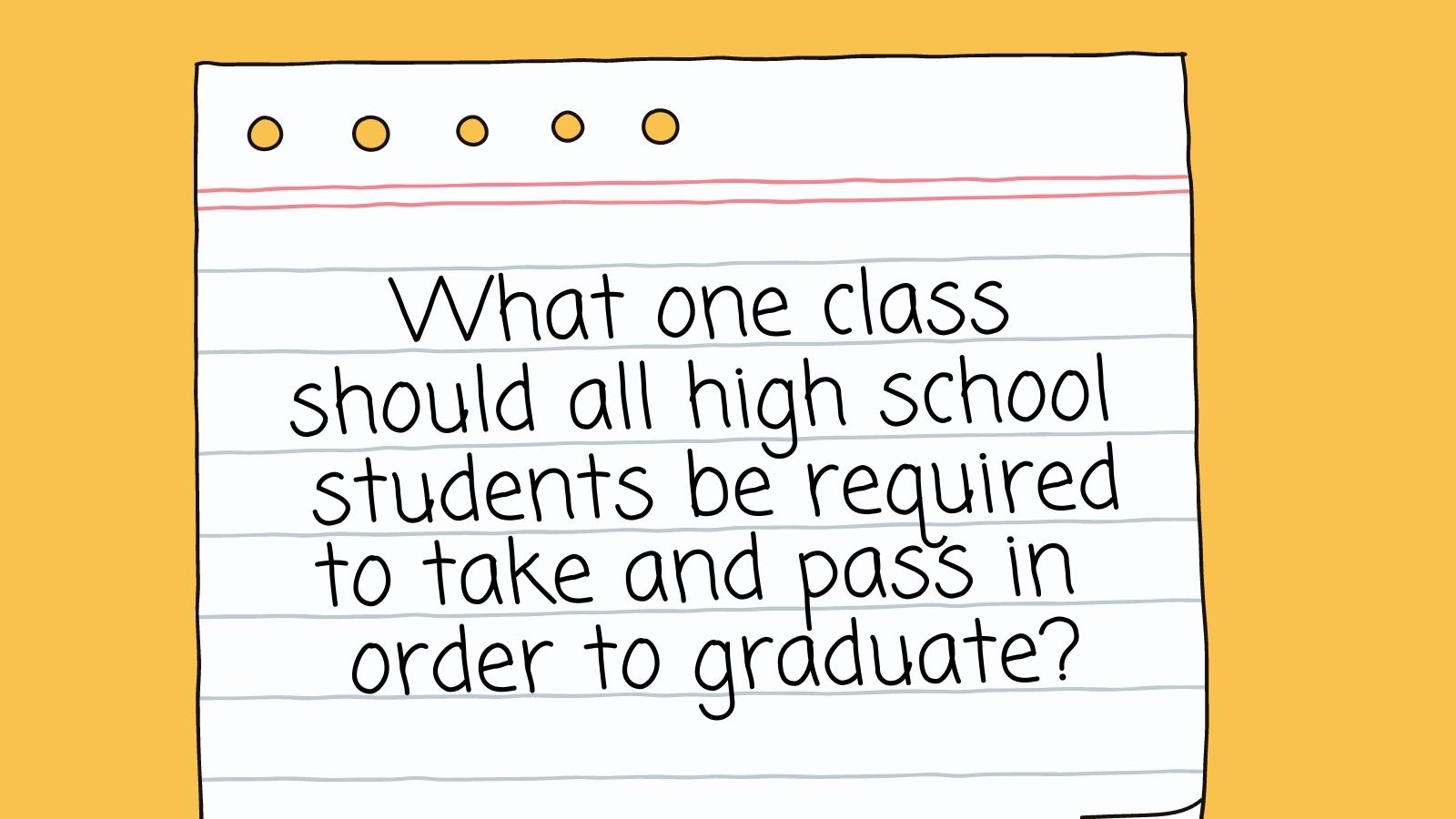
High school students generally do a lot of writing, learning to use language clearly, concisely, and persuasively. When it’s time to choose an essay topic, though, it’s easy to come up blank. If that’s the case, check out this huge round-up of essay topics for high school. You’ll find choices for every subject and writing style.
- Argumentative Essay Topics
- Cause-and-Effect Essay Topics
- Compare-Contrast Essay Topics
- Descriptive Essay Topics
- Expository and Informative Essay Topics
- Humorous Essay Topics
Literary Essay Topics
- Narrative and Personal Essay Topics
- Personal Essay Topics
- Persuasive Essay Topics
Research Essay Topics
Argumentative essay topics for high school.
When writing an argumentative essay, remember to do the research and lay out the facts clearly. Your goal is not necessarily to persuade someone to agree with you, but to encourage your reader to accept your point of view as valid. Here are some possible argumentative topics to try. ( Here are 100 more compelling argumentative essay topics. )
- The most important challenge our country is currently facing is … (e.g., immigration, gun control, economy)
- The government should provide free internet access for every citizen.
- All drugs should be legalized, regulated, and taxed.
- Vaping is less harmful than smoking tobacco.
- The best country in the world is …
- Parents should be punished for their minor children’s crimes.
- Should all students have the ability to attend college for free?
- Should physical education be part of the standard high school curriculum?
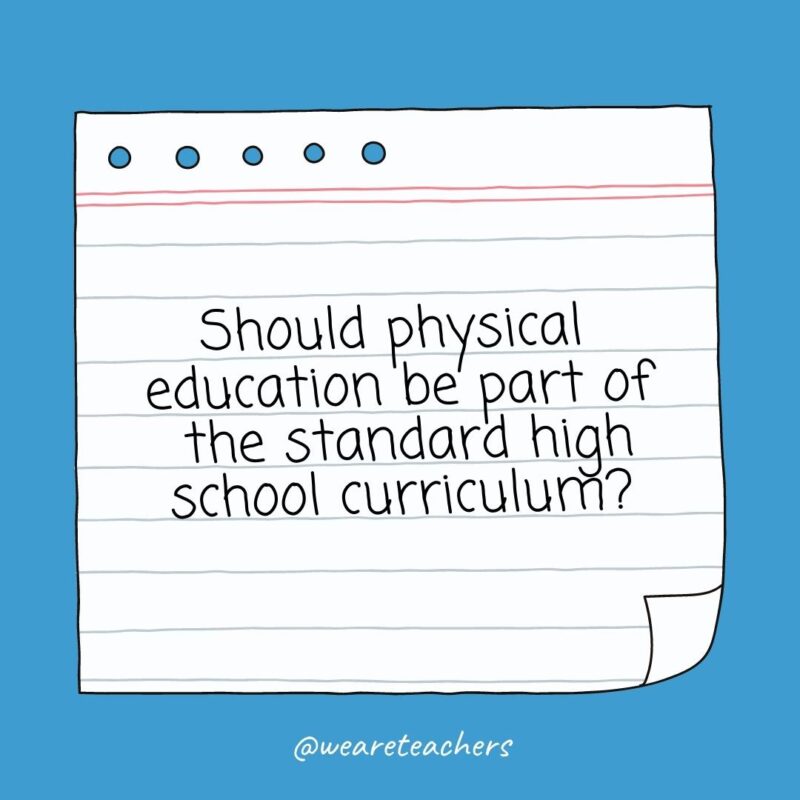
WeAreTeachers
- Schools should require recommended vaccines for all students, with very limited exceptions.
- Is it acceptable to use animals for experiments and research?
- Does social media do more harm than good?
- Capital punishment does/does not deter crime.
- What one class should all high schools students be required to take and pass in order to graduate?
- Do we really learn anything from history, or does it just repeat itself over and over?
- Are men and women treated equally?
Cause-and-Effect Essay Topics for High School
A cause-and-effect essay is a type of argumentative essay. Your goal is to show how one specific thing directly influences another specific thing. You’ll likely need to do some research to make your point. Here are some ideas for cause-and-effect essays. ( Get a big list of 100 cause-and-effect essay topics here. )
- Humans are causing accelerated climate change.
- Fast-food restaurants have made human health worse over the decades.
- What caused World War II? (Choose any conflict for this one.)
- Describe the effects social media has on young adults.
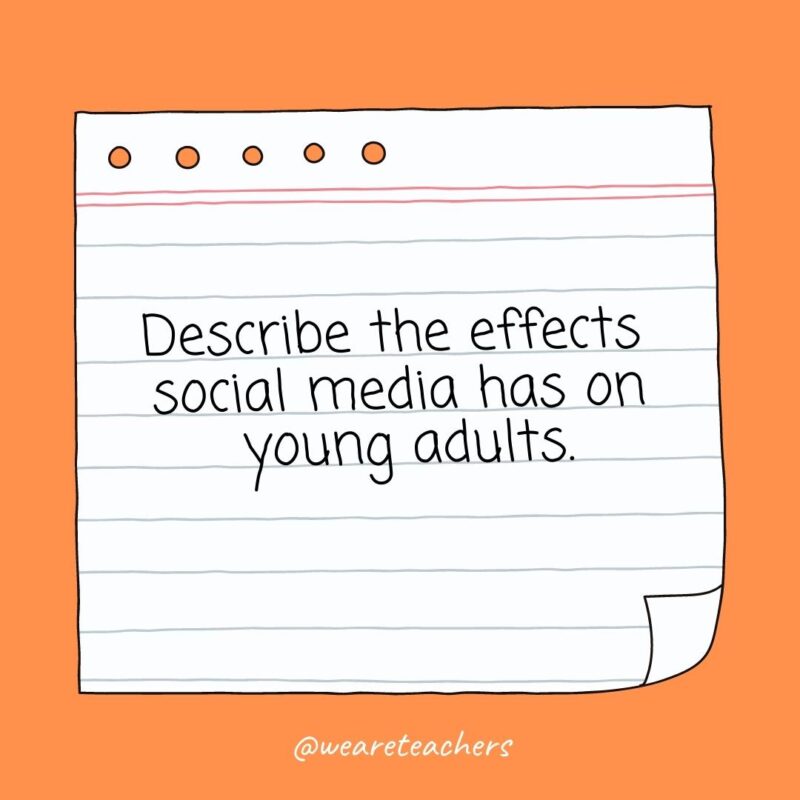
- How does playing sports affect people?
- What are the effects of loving to read?
- Being an only/oldest/youngest/middle child makes you …
- What effect does violence in movies or video games have on kids?
- Traveling to new places opens people’s minds to new ideas.
- Racism is caused by …
Compare-Contrast Essay Topics for High School
As the name indicates, in compare-and-contrast essays, writers show the similarities and differences between two things. They combine descriptive writing with analysis, making connections and showing dissimilarities. The following ideas work well for compare-contrast essays. ( Find 80+ compare-contrast essay topics for all ages here. )
- Public and private schools
- Capitalism vs. communism
- Monarchy or democracy
- Dogs vs. cats as pets
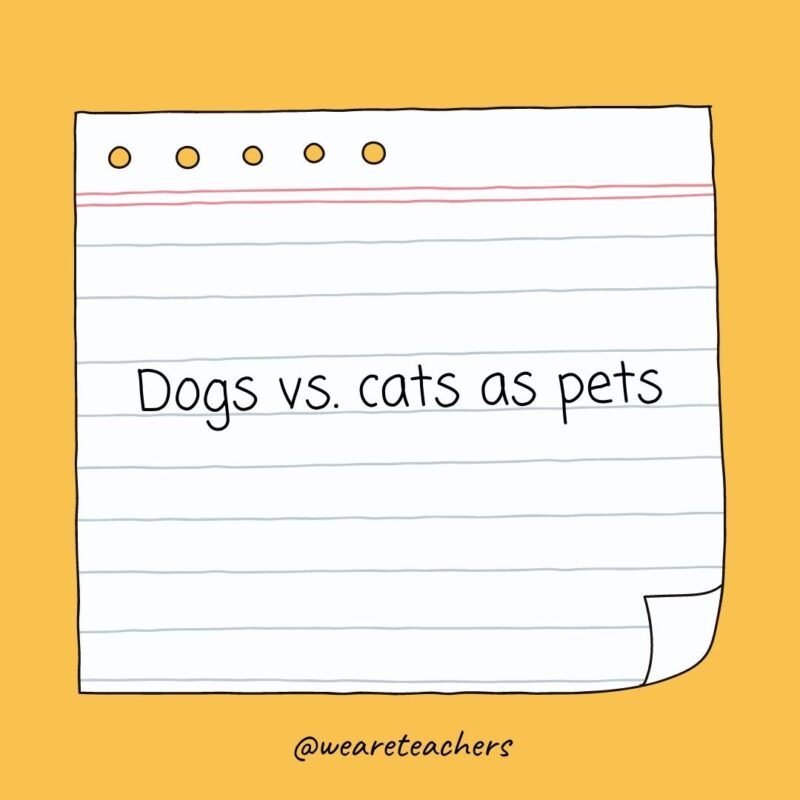
- Paper books or e-books
- Two political candidates in a current race
- Going to college vs. starting work full-time
- Working your way through college as you go or taking out student loans
- iPhone or Android
- Instagram vs. Twitter (or choose any other two social media platforms)
Descriptive Essay Topics for High School
Bring on the adjectives! Descriptive writing is all about creating a rich picture for the reader. Take readers on a journey to far-off places, help them understand an experience, or introduce them to a new person. Remember: Show, don’t tell. These topics make excellent descriptive essays.
- Who is the funniest person you know?
- What is your happiest memory?
- Tell about the most inspirational person in your life.
- Write about your favorite place.
- When you were little, what was your favorite thing to do?
- Choose a piece of art or music and explain how it makes you feel.
- What is your earliest memory?
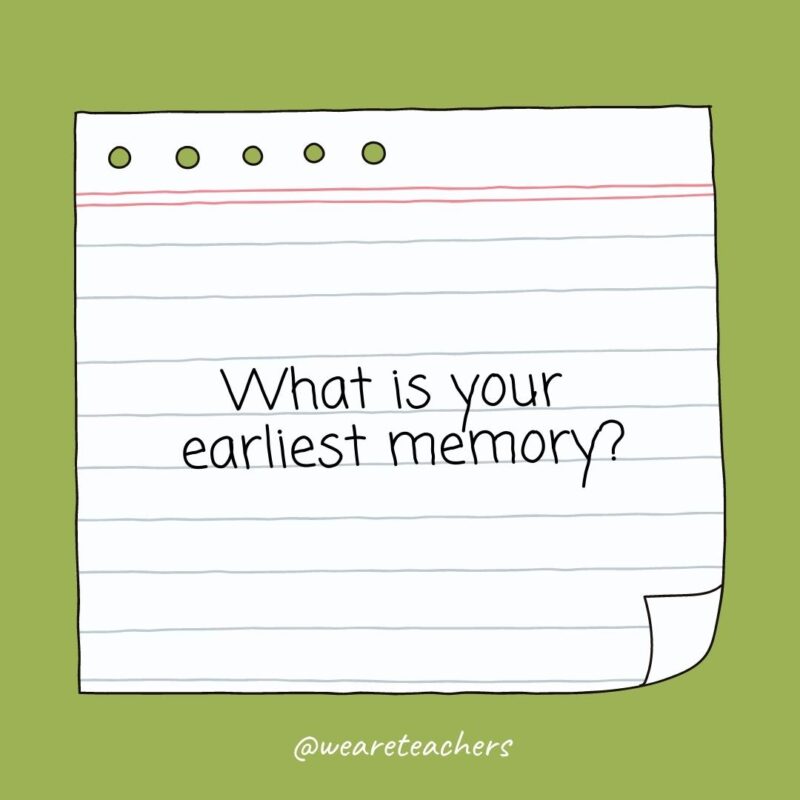
- What’s the best/worst vacation you’ve ever taken?
- Describe your favorite pet.
- What is the most important item in the world to you?
- Give a tour of your bedroom (or another favorite room in your home).
- Describe yourself to someone who has never met you.
- Lay out your perfect day from start to finish.
- Explain what it’s like to move to a new town or start a new school.
- Tell what it would be like to live on the moon.
Expository and Informative Essay Topics for High School
Expository essays set out clear explanations of a particular topic. You might be defining a word or phrase or explaining how something works. Expository or informative essays are based on facts, and while you might explore different points of view, you won’t necessarily say which one is “better” or “right.” Remember: Expository essays educate the reader. Here are some expository and informative essay topics to explore. ( See 70+ expository and informative essay topics here. )
- What makes a good leader?
- Explain why a given school subject (math, history, science, etc.) is important for students to learn.
- What is the “glass ceiling” and how does it affect society?
- Describe how the internet changed the world.
- What does it mean to be a good teacher?
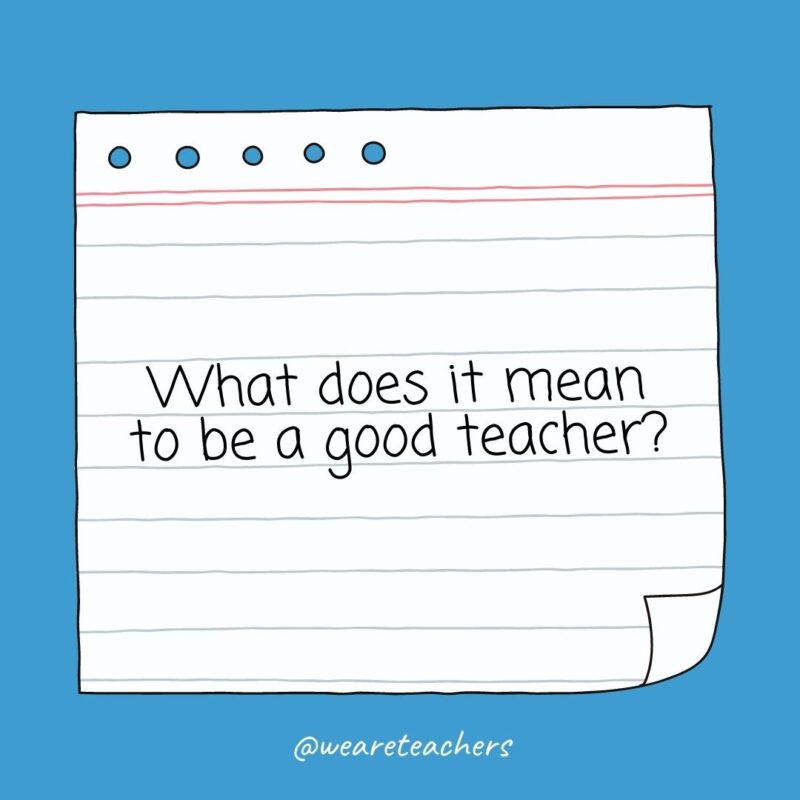
- Explain how we could colonize the moon or another planet.
- Discuss why mental health is just as important as physical health.
- Describe a healthy lifestyle for a teenager.
- Choose an American president and explain how their time in office affected the country.
- What does “financial responsibility” mean?
Humorous Essay Topics for High School
Humorous essays can take on any form, like narrative, persuasive, or expository. You might employ sarcasm or satire, or simply tell a story about a funny person or event. Even though these essay topics are lighthearted, they still take some skill to tackle well. Give these ideas a try.
- What would happen if cats (or any other animal) ruled the world?
- What do newborn babies wish their parents knew?
- Explain the best ways to be annoying on social media.
- Invent a wacky new sport, explain the rules, and describe a game or match.
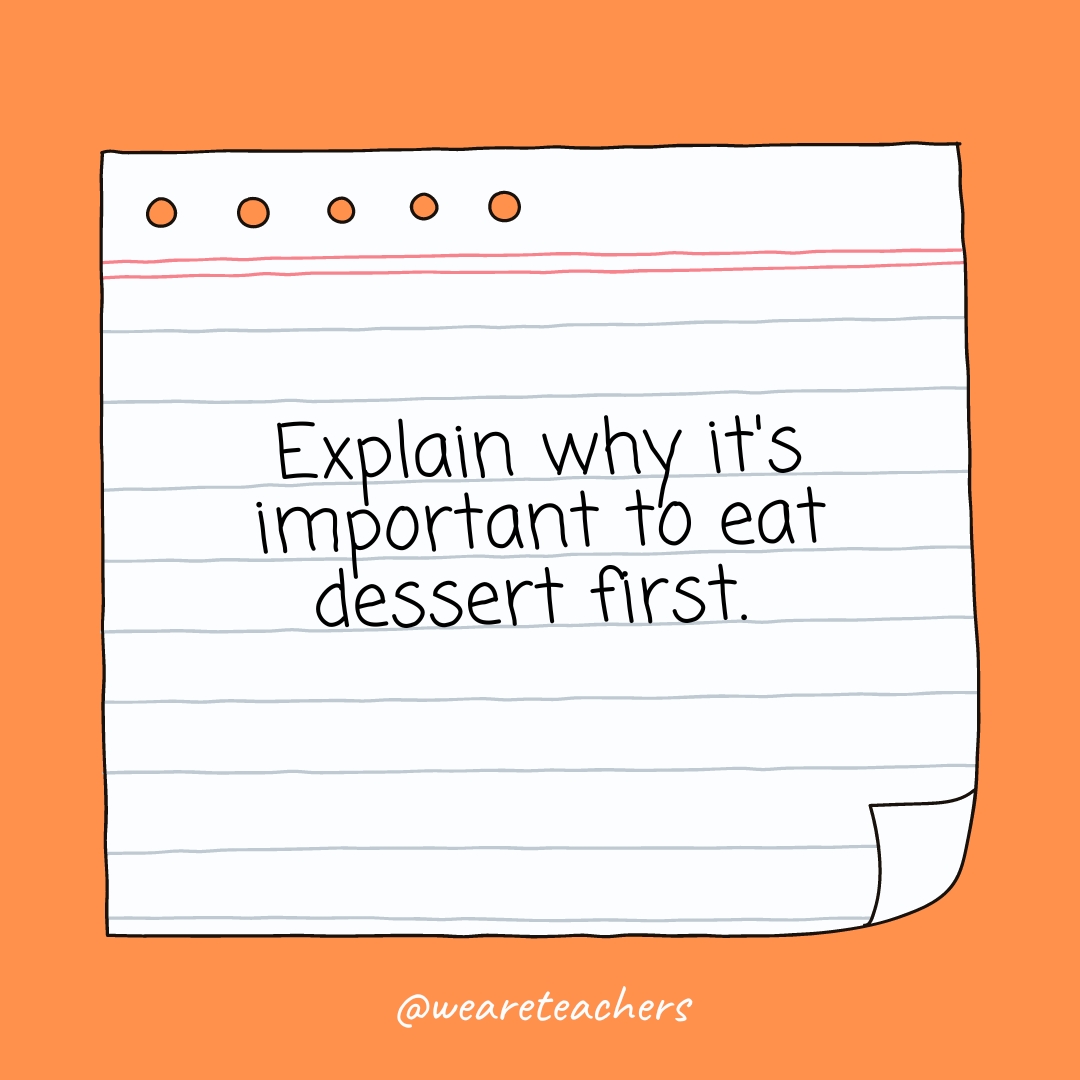
- Imagine a discussion between two historic figures from very different times, like Cleopatra and Queen Elizabeth I.
- Retell a familiar story in tweets or other social media posts.
- Describe present-day Earth from an alien’s point of view.
- Choose a fictional character and explain why they should be the next president.
- Describe a day when kids are in charge of everything, at school and at home.
Literary essays analyze a piece of writing, like a book or a play. In high school, students usually write literary essays about the works they study in class. These literary essay topic ideas focus on books students often read in high school, but many of them can be tweaked to fit other works as well.
- Discuss the portrayal of women in Shakespeare’s Othello .
- Explore the symbolism used in The Scarlet Letter .
- Explain the importance of dreams in Of Mice and Men .
- Compare and contrast the romantic relationships in Pride and Prejudice .
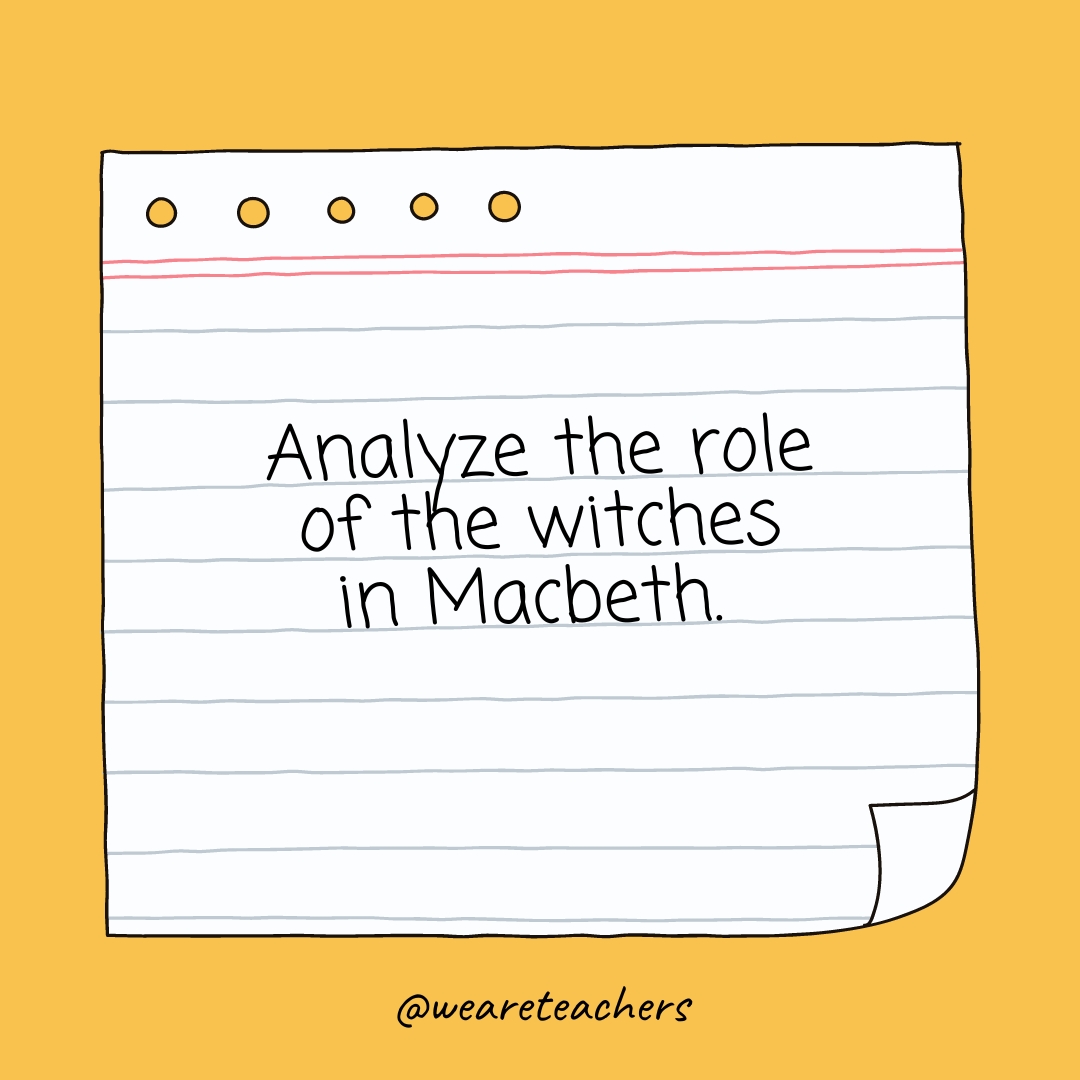
- Dissect the allegory of Animal Farm and its relation to contemporary events.
- Interpret the author’s take on society and class structure in The Great Gatsby .
- Explore the relationship between Hamlet and Ophelia.
- Discuss whether Shakespeare’s portrayal of young love in Romeo and Juliet is accurate.
- Explain the imagery used in Beowulf .
Narrative and Personal Essay Topics for High School
Think of a narrative essay like telling a story. Use some of the same techniques that you would for a descriptive essay, but be sure you have a beginning, middle, and end. A narrative essay doesn’t necessarily need to be personal, but they often are. Take inspiration from these narrative and personal essay topics.
- Describe a performance or sporting event you took part in.
- Explain the process of cooking and eating your favorite meal.
- Write about meeting your best friend for the first time and how your relationship developed.
- Tell about learning to ride a bike or drive a car.
- Describe a time in your life when you’ve been scared.
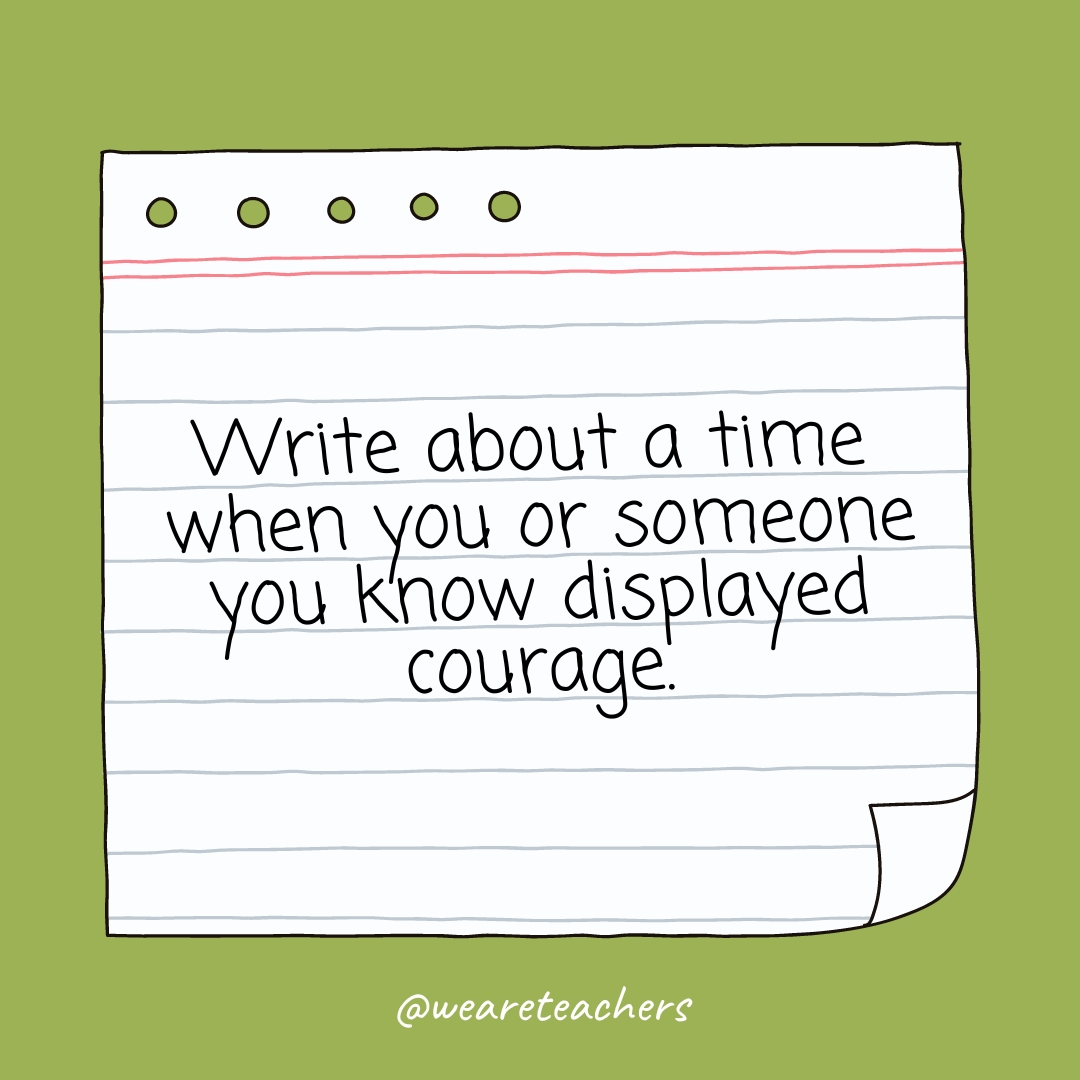
- Share the most embarrassing thing that ever happened to you.
- Tell about a time when you overcame a big challenge.
- Tell the story of how you learned an important life lesson.
- Describe a time when you or someone you know experienced prejudice or oppression.
- Explain a family tradition, how it developed, and its importance today.
- What is your favorite holiday? How does your family celebrate it?
- Retell a familiar story from the point of view of a different character.
- Describe a time when you had to make a difficult decision.
- Tell about your proudest moment.
Persuasive Essay Topics for High School
Persuasive essays are similar to argumentative , but they rely less on facts and more on emotion to sway the reader. It’s important to know your audience, so you can anticipate any counterarguments they might make and try to overcome them. Try these topics to persuade someone to come around to your point of view. ( Discover 60 more intriguing persuasive essay topics here. )
- Do you think homework should be required, optional, or not given at all?
- Everyone should be vegetarian or vegan.
- What animal makes the best pet?
- Visit an animal shelter, choose an animal that needs a home, and write an essay persuading someone to adopt that animal.
- Who is the world’s best athlete, present or past?
- Should little kids be allowed to play competitive sports?
- Are professional athletes/musicians/actors overpaid?
- The best music genre is …
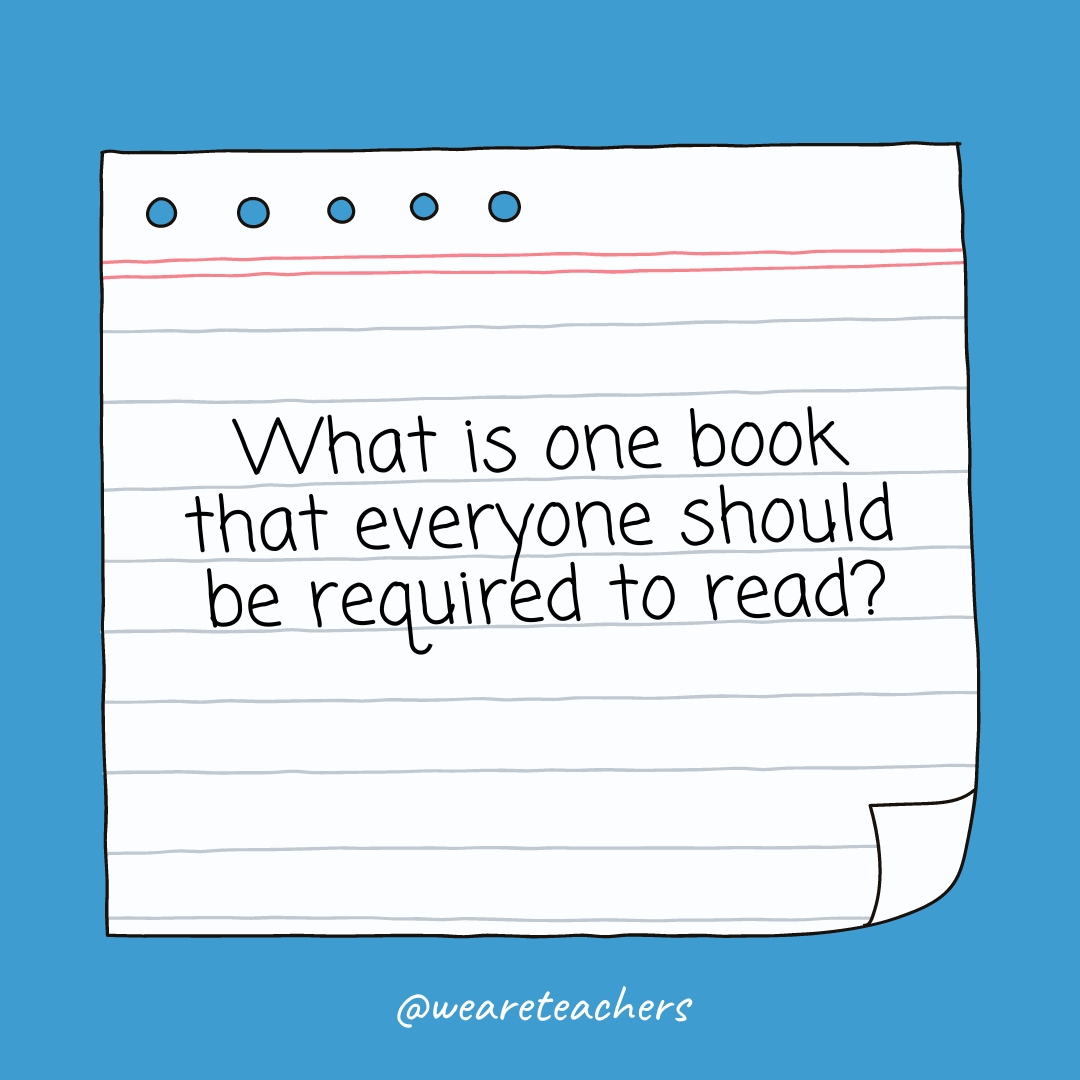
- Is democracy the best form of government?
- Is capitalism the best form of economy?
- Students should/should not be able to use their phones during the school day.
- Should schools have dress codes?
- If I could change one school rule, it would be …
- Is year-round school a good idea?
A research essay is a classic high school assignment. These papers require deep research into primary source documents, with lots of supporting facts and evidence that’s properly cited. Research essays can be in any of the styles shown above. Here are some possible topics, across a variety of subjects.
- Which country’s style of government is best for the people who live there?
- Choose a country and analyze its development from founding to present day.
- Describe the causes and effects of a specific war.
- Formulate an ideal economic plan for our country.
- What scientific discovery has had the biggest impact on life today?
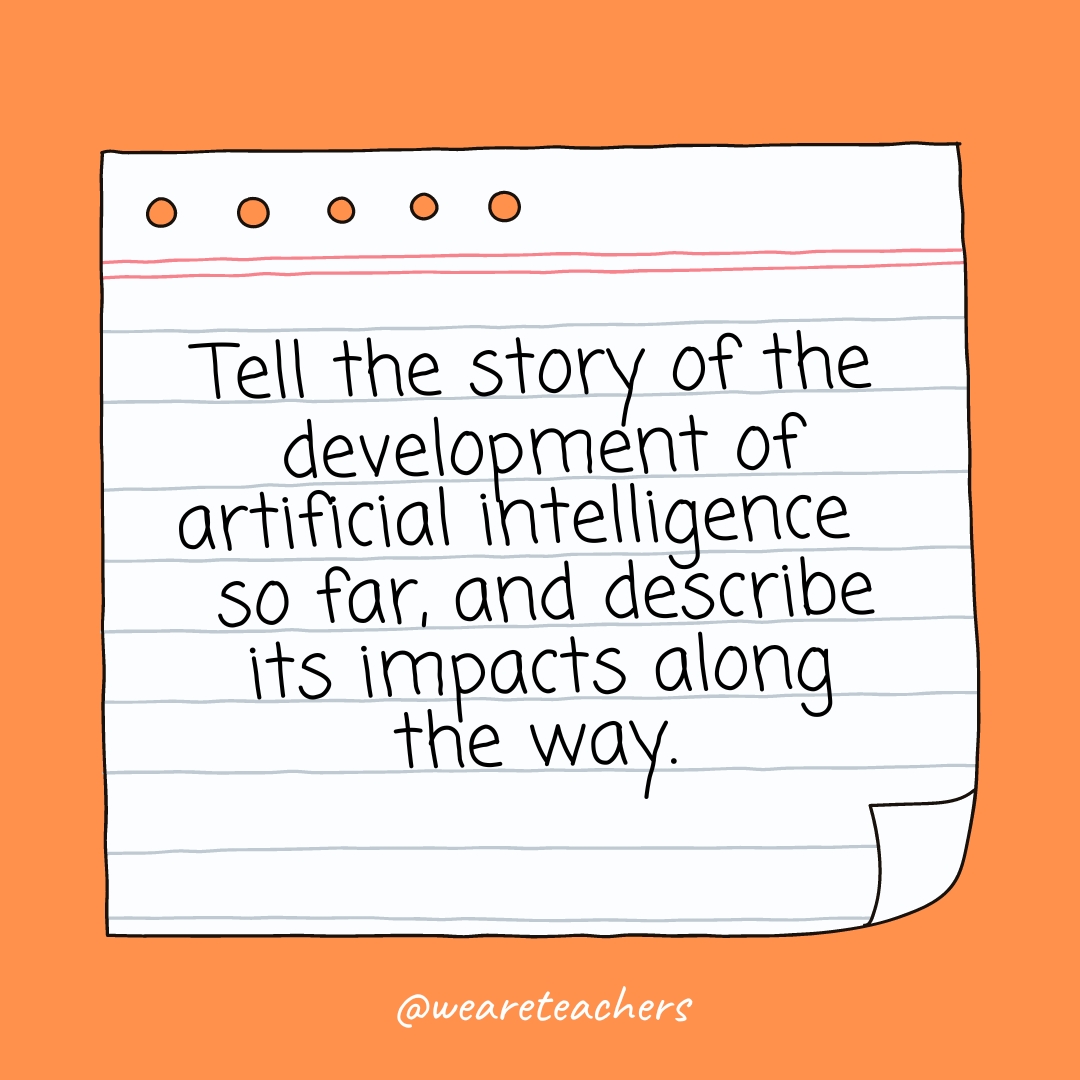
- Analyze the way mental health is viewed and treated in this country.
- Explore the ways systemic racism impacts people in all walks of life.
- Defend the importance of teaching music and the arts in public schools.
- Choose one animal from the endangered species list, and propose a realistic plan to protect it.
What are some of your favorite essay topics for high school? Come share your prompts on the WeAreTeachers HELPLINE group on Facebook .
Plus, check out the ultimate guide to student writing contests .
We Are Teachers
You Might Also Like
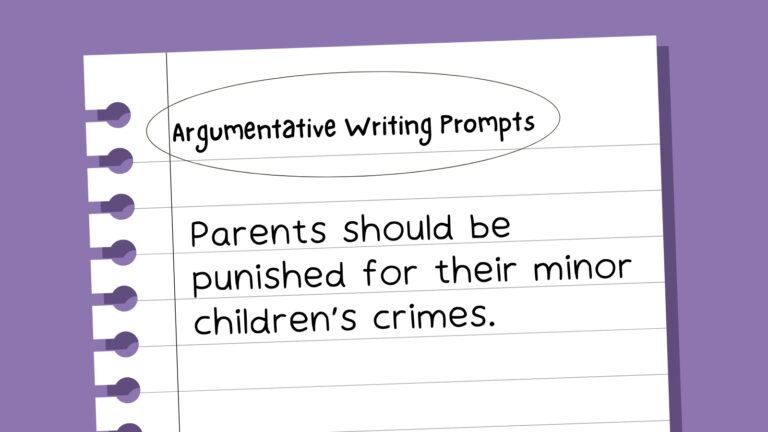
100 Thought-Provoking Argumentative Writing Prompts for Kids and Teens
Practice making well-reasoned arguments using research and facts. Continue Reading
Copyright © 2023. All rights reserved. 5335 Gate Parkway, Jacksonville, FL 32256
Narrative Essay High School Writing Unit With Lesson Plans and Sample Writing

- Google Apps™
- Easel Activity
What educators are saying
Products in this bundle (6).
showing 1 - 5 of 6 products
Also included in
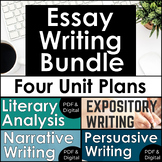
Description
Do you teach Narrative Writing in high school? If so, this Narrative Writing Unit Plan with graphic organizers, lesson plans, and sample writing is for you! Your students will write a powerful personal narrative essay with this complete 2-week unit plan! Lesson plans guide students through the writing process, daily bell ringers instruct and engage, and sample writing keeps students on the right track. This no-prep unit has everything you need - all the work has been done! Click the preview for more detailed information.
Includes PDF to print and all student materials writeable in Google Slides.
⭐ 10 Detailed Lesson Plans & a Unit Calendar
⭐ Sample Student Writing
⭐ Student Writing Packet
⭐ Common Core Standards
⭐ Engaging Bell Ringers for the Entire Writing Process
⭐ Common Core Rubric
⭐ Instructions to display for students including IF/THEN Charts and instructions for Round Table Editing
Top Love and Let Lit Resources
⭐ Romeo and Juliet Unit Plan
⭐ Expository Writing Essay Unit
⭐ To Kill a Mockingbird Unit Plan
Be the first to know about my new discounts, freebies and products:
• Look for the green star next to my profile picture and click it to become a follower. You’ll receive updates when I post products, freebies and discounts.
How to get TPT credit to use on future purchases:
• Please go to your My Purchases page. Beside each purchase you'll see a Provide Feedback button. Simply click it and you will be taken to a page where you can give a quick rating and leave a short comment for the product. Each time you give feedback, TPT gives you feedback credits you can use to lower the cost of your future purchases. Thank you!
Created By: Jacque Decker of Love and Let Lit
Questions & Answers
Love and let lit.
- We're hiring
- Help & FAQ
- Privacy policy
- Student privacy
- Terms of service
- Tell us what you think
High School Essay Writing for ESL and EFL Learners
Class experience
Us grade 9 - 12, homework offered, assessments offered, grades offered.
Group Class
Financial assistance , outschool international , get the app .

More to Explore
Classes by age , classes by grade .
ELA Brave and True by Marilyn Yung
Teaching transitions in writing, part 1 (updated 6/2021)

Don’t teach just transition words… teach transition ideas as well.
Note added on June 5, 2021: I often go back to my previous blog posts and see the details of how I taught a certain book or writing mini-lesson. In fact, I recently did that with this post. In April, I was working with my junior English classes and I used the photos from Chasing Lincoln’s Killer as examples of ways to connect the six essays they had compiled for their “Transcendentalism and the American Identity” essays. Having this blog post handy helped them see actual examples from the “real world” of ways to connect their essays into a cohesive whole. This is another way to show students that their sentences, paragraphs, and even sections of an essay should “hold hands” for better flow and clarity, as the text They Say, I Say suggests. And now back to our regularly scheduled programming. 🙂
I taught this book for eight years in my middle school ELA classes. It’s such a ride! Plus, when you read it as a writer, you notice key skills the author James Swanson utilized heavily when he wrote this little gem.
For me, teaching transitions is one of the most difficult concepts to teach in writing and one of the most needed. When you teach transitions, you are helping students learn how to write smoothly, to make their ideas flow from one paragraph to the next, even from one sentence to the next.
In short, we’re talking about the concept of cohesion in writing. As you know, cohesion happens when an idea is carried through from the introductory paragraph(s) to the supporting sections of the text and finally, to the summary or conclusion. There are two ways to accomplish cohesion: transition words and ideas as transitions.
Transition words
I’ve done what many other teachers have done. We post anchor charts around our classrooms that divide transition words into groups based on their intended jobs within a piece of writing. It’s a fairly cut-and-dry skill to teach. Here are three examples of many:
- Transitions that show sequence: first, second, third, etc.
- Transitions that show cause and effect: as a result, consequently, etc.
- Transitions that compare and contrast: on the other hand, in contrast, etc.
Yes, anchor charts do an adequate job of supplying these phrases for students as they write. In addition, I’ve also distributed handouts that list these same groups of words. And that’s all fine and good. Most students understand how transition words can help their writing flow smoothly so the reader can easily follow their ideas.
Transition ideas
But there’s another kind of transition—transition ideas—that are just as important, if not more important, than all those transition words. It’s also more difficult to teach because you can’t point to a list of words and phrases for students to use. That’s why I was excited when I found several examples of transition ideas in a text that I routinely taught, Chasing Lincoln’s Killer by James Swanson.
Transition ideas rely on words used in the text by the author to connect the scenes in a story, the claim in an argument from one paragraph to the next, or important big ideas in an informative article.

Chasing Lincoln’s Killer contains several examples of transition ideas. And since it’s often easier for me to show this than it is to explain it, take a look at the photos below.
The first photo below is from Chapter IV in the book. I’ve underlined in red the transition ideas… places where the writer wanted to move the story from one scene to another on the night of April 14, 1865 when President Lincoln was assassinated. To continue his story from one location to another Swanson utilized key words to carry the reader from the home of Secretary of State William Seward to the scene of the Lincoln shooting, Ford’s Theater.
As you can see, Swanson intentionally repeated key words and phrases–“drenched in blood”– to help his reader make the leap in the story with him.

Here’s another example. Swanson’s narrative needed to transfer from the farm and home of Dr. Mudd back to Ford’s Theater. Swanson showed the Mudds sleeping and transitioned that idea to President Lincoln, who was also “sleeping” after being shot by the assassin John Wilkes Booth.

Below is yet another example where Swanson carries the reader, at the conclusion of Chapter VII, into the action of Chapter VIII. He uses transition ideas to switch the reader from the lowland river areas where Booth and conspirator David Herold prepared for camping to Washington, D.C., where Mary Surratt, another conspirator, also was wrapping up the busy day.

And below you can see how Swanson began Chapter VIII in a way that echoed the action at the end of Chapter VII.

If you’d like even more explanation of transition ideas, show your middle school and high school students this video by Shmoop . It’s quirky and a little weird, but that’s Shmoop. It gets the point across well, I think.
Transition words and transition ideas are super important. They help students write smoothly and cohesively. Both are the key to writing pieces that absorb the reader, causing them to focus intently on the message of the writing. Use these passages from Chasing Lincoln’s Killer and this Shmoop video the next time you prepare a mini-lesson on transitions.
How do you teach transitions? Leave a comment to share your ideas and follow my blog for weekly ELA teaching posts.
Need a new poetry lesson.
Enter your email below and I’ll send you this PDF file that will teach your students to write Treasured Object Poems , one of my favorite poem activities. I know your students will enjoy it!

By clicking submit, you agree to share your email address with the site owner and Mailchimp to receive marketing, updates, and other emails from the site owner. Use the unsubscribe link in those emails to opt out at any time.
Share this:
- Click to share on Twitter (Opens in new window)
- Click to share on Facebook (Opens in new window)
- Click to share on Pinterest (Opens in new window)
- Click to print (Opens in new window)
- Click to share on LinkedIn (Opens in new window)
- Click to email a link to a friend (Opens in new window)
Published by Marilyn Yung
Writes | Teaches | Not sure where one ends and the other begins. View more posts
5 thoughts on “ Teaching transitions in writing, part 1 (updated 6/2021) ”
This is great! I love looking for author’s techniques for students to use in their writing. And this is such a good mentor text.
Thank you so much! Yes, this is such a great book. Now that I teach high school, I’m thinking of using Swanson’s Manhunt, the book CLK is based on, with them.
- Pingback: Teaching transitions in writing, part 2 – ELA Brave and True: A Blog by Marilyn Yung
- Pingback: My Top 12 Posts of 2020 – ELA Brave and True by Marilyn Yung
- Pingback: My Top 10 Posts of 2021 – ELA Brave and True by Marilyn Yung
Leave a Reply Cancel reply
Discover more from ela brave and true by marilyn yung.
Subscribe now to keep reading and get access to the full archive.
Type your email…
Continue reading
- Skip to primary navigation
- Skip to main content
- 110 Baker St. Moscow, ID 83843
- 208.882.1226
A Classical & Christ-Centered Education

Secondary Curriculum
The secondary school is divided into two stages… grades 7-8 (the Logic Stage) and grades 9-12 (the Rhetoric Stage).
In grades 7-8, the students take the mastered information from the Grammar Stage and bring it into ordered relationships. Students begin to apply logic, assessing the validity of arguments and learning to view information critically with more discerning minds.
In grades 9-12, students learn to articulate eloquently and persuasively, and to use the tools of knowledge and understanding acquired in the earlier stages. This is the point at which the strength of a classical education is made fully visible.
Click here for an overview of the Logos School secondary curriculum.
Click for our 2-page School Profile
The Knight’s Creed and Commitment
Class Schedules
Fall 2023 Finals Schedule 7th-12th grades only.
23-24 Fall Class Schedule 7th-12th grades only.
Senior Course Options:
By the time students reach their senior year in high school, they have usually developed interests in specific areas. Therefore, they will be given the opportunity to pursue those areas through the following senior course options. These options are designed to allow students the opportunity to learn one or two subjects well. As Dorothy Sayers says, “Whatever is mere apparatus may now be allowed to fall into the background, while the trained mind is gradually prepared for specialization in the “subjects” which, when the Trivium is completed, it should be perfectly well equipped to tackle on its own.” (from The Lost Tools of Learning) These options should aid the transition from the completion of the Trivium to the more specialized study that is a part of a college or university education.
Option 1: College or Online Class
This is a 1 credit option in which a student enrolls in a college or online class. Approved subjects include math, science, theology, humanities, and fine arts. The class must be taken for credit and the student must submit a transcript to receive credit toward Logos graduation. Areas of study that do not qualify are recreational classes and/or self-guided courses with little accountability.
Option 2: Internship
The internship is a 1/2 credit option intended to provide seniors with the opportunity to study a career. Students must work a minimum of 2 hours per week on their internship. A variety of internships have been approved in the past (interning with an elementary or secondary Logos teacher, riding along with police officers, observing at a local vet clinic, etc.). Students are not allowed to be paid for the time they spend as an intern. Parents are responsible to provide oversight and any necessary supervision or screening (background checks, etc.) for this experience.
Procedures for Both Options
1. At least two weeks before the beginning of each semester, students must submit a written proposal to the principal, via email. Late proposals will not be considered. Proposals must describe the following:
a. the main purpose of and goals for the program
b. the work that the student will be doing weekly to achieve these goals (include the website link for online classes)
c. the number of hours per week that the student will be participating in the program
2. Students have two days to resubmit proposals that have been denied.
Guidelines for Both Options
1. Credit will not be granted for work completed before a proposal is approved.
2. Students will receive a grade of E, S, or U at the end of each quarter and semester.
3. Failure to make satisfactory progress in the first semester will disqualify the student from participating in these programs during the second semester.
4. Students may only request approval for one semester at a time.
College Planning Handbook
This link contains detailed information on preparing for college.
Dialectic Speech Meet
The following is information for the Dialectic Speech Meet for the 7 th -9 th grade students. Most of the work and grading is done during English class. For the final meet onwards, the students will perform their pieces with students from other classes in the same category. That afternoon during 7 th period there will be an assembly to hear the top performances from each category.
- Mid-December – information goes home
- Mid-January – Selections are due
- Toward the end of January – Piece is presented for a grade
- Beginning of February – Speech Meet
Dialectic Speech Meet Guidelines Dialectic Speech Meet Judge’s Form Dialectic Speech Meet Selection Ideas
Rhetoric Speech Meet
The following is information for the upcoming Rhetoric Speech Meet for the 10 th -12 th grade students. Please note a few differences between the Dialectic Speech Meet of the 7 th -9 th graders and the Rhetoric Speech Meet:
- Poetry must be through the Poetry Out Loud program.
- Readers Theater and the Original Oratory categories are allowed.
- Children’s books and plays are allowed as sources for material.
- There is no memory check. Pieces will be presented once in class for a grade, and once at the meet for a test grade.
- Mid-September – Information goes home.
- Beginning of October – Selections are due.
- Mid-October – The piece is presented for a memory grade.
- Beginning of November– Speech Meet
Guidelines Judging Form Selection Ideas
"I am a qualified primary school teacher, and decided to go for the exciting challenge and opportunity of working abroad, I had never considered Moscow until I spoke to Lisa, who sold it to me..."
Catherine Warren
"...I have been placed twice by ABL and have had a great experience in Moscow. Lisa and is both professional and extremely friendly. I feel well looked-after and someone is always on hand to assist and offer advice when needed."
Daryl Seager
"The process of finding a tutor was performed extremely professionally. We explored a number of options, and the follow up by ABL was excellent as well as being the only agency who recognized the visa process "
Jonathan Muir
"We have been using the services of ABL Personnel since 2010 and have been very impressed with the high level of service we receive from Lisa. She has found us highly qualified teachers and our children are very happy. Our eldest son has been accepted into a top private school in the UK. "
Nataliya O.
"I am a qualified teacher and wanted a new life experience. I was recommended to ABL Personnel and I think that because Lisa has lived and worked in Russia she was able to offer me some really sound advice and find an amazing family for me. I have now been in Moscow two years and I am loving my experience here. The family I work for have been so good to me and I am very happy with my job as a Governess. "
Elizabeth Taylor-Jones
"My experience with ABL Personnel has been nothing but professional. I have been placed with two VIP families covering maternity jobs and have always been respected and well looked after by my Russian employers. ABL have good connections with some very exclusive families and this is what matched my own experience so I am very satisfied"
Martha Wainwright
Tutor / Governess - Qatar
START DATE:
FULL DETAILS:
English Speaking Tutor / Governess - Live Out Position in Qatar: Start ASAP My client, a member of the Qatar Royal Family is seeking a formally qualified British teacher to work with her 16 year old daughter. The job is to help this young lady develop herself scholastically, especially in regards to her English, History and formal essay writing skills. The student speaks English however your command and passion for the English language will help her to further develop her own knowledge of the language and her ability to speak beautifully. My client is seeking a qualified teacher who has a true passion for teaching and a real desire to help educate her daughter both intellectually, socially and emotionally. You are to be her teacher, her friend and her role model so it is imperative that you possess intellect, a sense of humour and a deep interest in the world around you. You will have well developed teaching skills to guide your student’s mind whilst developing her intellect. My client seeks a teacher who can help her daughter engage in reading and develop a true love of one life’s most important past times. You must be well presented and well- spoken and be able to hold your own in any intellectual or social situation. As well as polite confidence we require a lady who easily smiles and shares her zest for life with those around her. The ideal candidate will have experience teaching the national curriculum and will ideally have previously worked for a High profile family, however I welcome teachers with just classroom based experience. You will need to be active and sporty and be able to swim. You will possess a cheerful and positive disposition and be flexible and willing to go the extra mile when required. This is a very high end family so they are looking for someone who is comfortable in all situations as you will be a role model through your display of good manners and etiquette. Your excellent communication skills and your lovely personality is what this family are looking for in a Governess. The family travel internationally, and as you will be required to accompany the young lady you need to be able to create exciting and intelligent lesson plans about the countries and cultures you will be visiting. Responsibilities: You would be responsible for supervising the afternoon daily routines and activities. Accompanying the young lady to high profile functions, during international travel, in both a sole and shared charge capacity, with the adaptability to intuitively know when needed and when to be discreetly available. • Expertly devises fun, creative learning opportunities that appeal to the young lady’s specific interests and hobbies • Delivers high quality, tailor made English and history lessons, engaging the young lady in imaginative, hands on activities to develop speaking, listening, reading, and writing – e.g. using innovative techniques to teach grammar and other usually mundane aspects of English language acquisition • Develop the young lady’s essay writing skills to a very high standard • Provide detailed feedback to parents and other family members when requested on the young lady’s wellbeing, social development and academic progress in form of bespoke reports, phone calls, text messages, emails and discussions where appropriate • Maintains professional, patient, flexible attitude to last minute requests, travel plans and changes to provide a good role model and promote a calm, happy environment despite disruptions • Build excellent relationships with non-English speaking staff at all levels and in many different locations, fitting in well to maintain smooth running of routines, security and travel plans Conditions • Working 6 afternoons per week with flexible hours • The salary is £1000 per week • Live out with fully furnished separate apartment in Doha • 4 weeks fully paid holidays per year • Visas and flights covered by employer Requirements • Start ASAP • Native English Speaking Person • Teaching qualification (B.Ed. or PGCE) • Previous experience in a similar role preferred • Creative, positive, outgoing person To apply please forward your CV, cover letter and a recent photograph. Or call me to discuss this job further, thank you Lisa [email protected] Ph.07885405192
APPLY FOR THIS JOB
UPLOAD COVER LETTER
UPLOAD PHOTO
WELCOME TO THE FAMILY! Please check your email for confirmation from us.
Sob stories? Trauma dumps? Black kids worry about writing college essays after affirmative action ban
When the Supreme Court ended affirmative action in higher education, it left the college essay as one of few places where race can play a role in admissions decisions.
- Share on Facebook
- Share on Twitter
- Share via Email
- Copy Link Link Copied
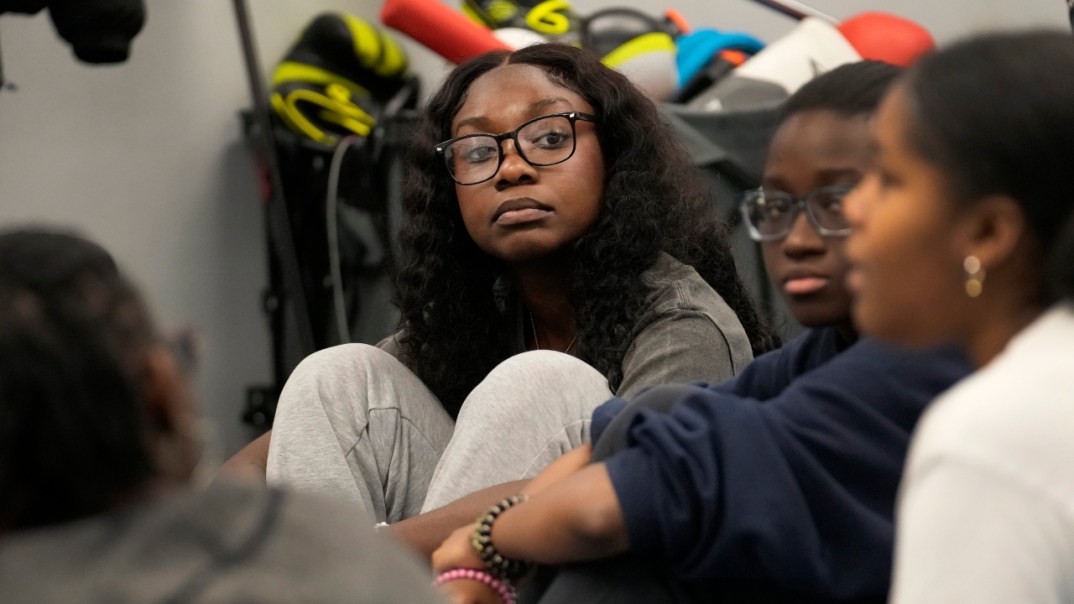
CHICAGO (AP) — When she started writing her college essay, Hillary Amofa told the story she thought admissions offices wanted to hear. About being the daughter of immigrants from Ghana and growing up in a small apartment in Chicago. About hardship and struggle.
Then she deleted it all.
“I would just find myself kind of trauma-dumping,” said the 18-year-old senior at Lincoln Park High School in Chicago. “And I’m just like, this doesn’t really say anything about me as a person.”
When the Supreme Court ended affirmative action in higher education , it left the college essay as one of few places where race can play a role in admissions decisions. For many students of color, instantly more was riding on the already high-stakes writing assignment. Some say they felt pressure to exploit their hardships as they competed for a spot on campus.
Amofa was just starting to think about her essay when the court issued its decision, and it left her with a wave of questions. Could she still write about her race? Could she be penalized for it? She wanted to tell colleges about her heritage but she didn’t want to be defined by it.
In English class, Amofa and her classmates read sample essays that all seemed to focus on some trauma or hardship. It left her with the impression she had to write about her life’s hardest moments to show how far she’d come. But she and some of her classmates wondered if their lives had been hard enough to catch the attention of admissions offices.
“For a lot of students, there’s a feeling of, like, having to go through something so horrible to feel worthy of going to school, which is kind of sad,” said Amofa, the daughter of a hospital technician and an Uber driver.
This year’s senior class is the first in decades to navigate college admissions without affirmative action. The Supreme Court upheld the practice in decisions going back to the 1970s, but this court’s conservative supermajority found it is unconstitutional for colleges to give students extra weight because of their race alone.
Still, the decision left room for race to play an indirect role: Chief Justice John Roberts wrote universities can still consider how an applicant’s life was shaped by their race, “so long as that discussion is concretely tied to a quality of character or unique ability.”
“A benefit to a student who overcame racial discrimination, for example, must be tied to that student’s courage and determination,” he wrote.
Scores of colleges responded with new essay prompts asking about students’ backgrounds. Brown University asked applicants how “an aspect of your growing up has inspired or challenged you.” Rice University asked students how their perspectives were shaped by their “background, experiences, upbringing, and/or racial identity.”
Wondering if schools ‘expect a sob story’
When Darrian Merritt started writing his essay, he knew the stakes were higher than ever because of the court’s decision. His first instinct was to write about events that led to him going to live with his grandmother as a child.
Those were painful memories, but he thought they might play well at schools like Yale, Stanford and Vanderbilt.
“I feel like the admissions committee might expect a sob story or a tragic story,” said Merritt, a senior in Cleveland. “And if you don’t provide that, then maybe they’re not going to feel like you went through enough to deserve having a spot at the university. I wrestled with that a lot.”
He wrote drafts focusing on his childhood, but it never amounted to more than a collection of memories. Eventually he abandoned the idea and aimed for an essay that would stand out for its positivity.
Merritt wrote about a summer camp where he started to feel more comfortable in his own skin. He described embracing his personality and defying his tendency to please others. The essay had humor — it centered on a water gun fight where he had victory in sight but, in a comedic twist, slipped and fell. But the essay also reflects on his feelings of not being “Black enough” and getting made fun of for listening to “white people music.”
“I was like, ‘OK, I’m going to write this for me, and we’re just going to see how it goes,’” he said. “It just felt real, and it felt like an honest story.”
The essay describes a breakthrough as he learned “to take ownership of myself and my future by sharing my true personality with the people I encounter. … I realized that the first chapter of my own story had just been written.”
A ruling prompts pivots on essay topics
Like many students, Max Decker of Portland, Oregon, had drafted a college essay on one topic, only to change direction after the Supreme Court ruling in June.
Decker initially wrote about his love for video games. In a childhood surrounded by constant change, navigating his parents’ divorce, the games he took from place to place on his Nintendo DS were a source of comfort.
But the essay he submitted to colleges focused on the community he found through Word is Bond, a leadership group for young Black men in Portland.
As the only biracial, Jewish kid with divorced parents in a predominantly white, Christian community, Decker wrote he constantly felt like the odd one out. On a trip with Word is Bond to Capitol Hill, he and friends who looked just like him shook hands with lawmakers. The experience, he wrote, changed how he saw himself.
Recommended Stories

Ahmaud Arbery’s killers seeking to overturn their hate crime convictions
Associated Press

High school teacher and students sue over Arkansas’ ban on critical race theory

House Republicans aim to strip funding from medical schools over diversity programs
Ashlee Banks

DEI programs and concepts that could make someone feel guilty about their race banned in Alabama
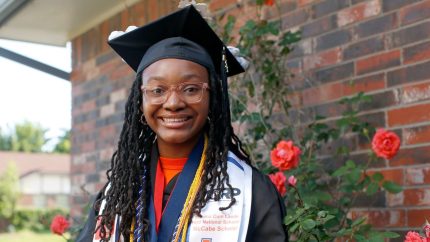
America’s youngest teacher is a 16-year-old MBA student
TheGrio Lifestyle

MF Doom and Madlib’s ‘Madvillainy’ — now 20 years old — is the timeless classic album we all thought it would be in 2004
Panama Jackson

Before heading ‘outside,’ spring-clean your finances in 4 steps
Jennifer Streaks
“It’s because I’m different that I provide something precious to the world, not the other way around,” he wrote.
As a first-generation college student, Decker thought about the subtle ways his peers seemed to know more about navigating the admissions process. They made sure to get into advanced classes at the start of high school, and they knew how to secure glowing letters of recommendation.
If writing about race would give him a slight edge and show admissions officers a fuller picture of his achievements, he wanted to take that small advantage.
His first memory about race, Decker said, was when he went to get a haircut in elementary school and the barber made rude comments about his curly hair. Until recently, the insecurity that moment created led him to keep his hair buzzed short.
Through Word is Bond, Decker said he found a space to explore his identity as a Black man. It was one of the first times he was surrounded by Black peers and saw Black role models. It filled him with a sense of pride in his identity. No more buzzcut.
The pressure to write about race involved a tradeoff with other important things in his life, Decker said. That included his passion for journalism, like the piece he wrote on efforts to revive a once-thriving Black neighborhood in Portland. In the end, he squeezed in 100 characters about his journalism under the application’s activities section.
“My final essay, it felt true to myself. But the difference between that and my other essay was the fact that it wasn’t the truth that I necessarily wanted to share,” said Decker, whose top college choice is Tulane, in New Orleans, because of the region’s diversity. “It felt like I just had to limit the truth I was sharing to what I feel like the world is expecting of me.”
Spelling out the impact of race
Before the Supreme Court ruling, it seemed a given to Imani Laird that colleges would consider the ways that race had touched her life. But now, she felt like she had to spell it out.
As she started her essay, she reflected on how she had faced bias or felt overlooked as a Black student in predominantly white spaces.
There was the year in math class when the teacher kept calling her by the name of another Black student. There were the comments that she’d have an easier time getting into college because she was Black.
“I didn’t have it easier because of my race,” said Laird, a senior at Newton South High School in the Boston suburbs who was accepted at Wellesley and Howard University , and is waiting to hear from several Ivy League colleges. “I had stuff I had to overcome.”

In her final essays, she wrote about her grandfather, who served in the military but was denied access to GI Bill benefits because of his race.
She described how discrimination fueled her ambition to excel and pursue a career in public policy.
“So, I never settled for mediocrity,” she wrote. “Regardless of the subject, my goal in class was not just to participate but to excel. Beyond academics, I wanted to excel while remembering what started this motivation in the first place.”
Will schools lose racial diversity?
Amofa used to think affirmative action was only a factor at schools like Harvard and Yale. After the court’s ruling, she was surprised to find that race was taken into account even at some public universities she was applying to.
Now, without affirmative action, she wondered if mostly white schools will become even whiter.
It’s been on her mind as she chooses between Indiana University and the University of Dayton, both of which have relatively few Black students. When she was one of the only Black students in her grade school, she could fall back on her family and Ghanaian friends at church. At college, she worries about loneliness.
“That’s what I’m nervous about,” she said. “Going and just feeling so isolated, even though I’m constantly around people.”
The first drafts of her essay focused on growing up in a low-income family, sharing a bedroom with her brother and grandmother. But it didn’t tell colleges about who she is now, she said.
Her final essay tells how she came to embrace her natural hair. She wrote about going to a mostly white grade school where classmates made jokes about her afro. When her grandmother sent her back with braids or cornrows, they made fun of those too.
Over time, she ignored their insults and found beauty in the styles worn by women in her life. She now runs a business doing braids and other hairstyles in her neighborhood.
“I stopped seeing myself through the lens of the European traditional beauty standards and started seeing myself through the lens that I created,” Amofa wrote.
“Criticism will persist, but it loses its power when you know there’s a crown on your head!”
Never miss a beat: Get our daily stories straight to your inbox with theGrio’s newsletter.
- Share on Facebook Facebook
- Share on Twitter Twitter
- Share via Email Email
- Copy Link Copy Link Link Copied

STREAM FREE MOVIES, LIFESTYLE AND NEWS CONTENT ON OUR NEW APP
2018 Primetime Emmy & James Beard Award Winner
R&K Insider
Join our newsletter to get exclusives on where our correspondents travel, what they eat, where they stay. Free to sign up.
A History of Moscow in 13 Dishes
Featured city guides.

IMAGES
VIDEO
COMMENTS
270 pages of the most effective teaching strategies; 50+ digital tools ready right out of the box 75 editable resources for student differentiation ; Loads of tricks and tips to add to your teaching tool bag; All explanations are reinforced with concrete examples.; Links to high-quality video tutorials; Clear objectives easy to match to the demands of your curriculum
Our 2020-21 Writing Curriculum for Middle and High School. A flexible, seven-unit program based on the real-world writing found in newspapers, from editorials and reviews to personal narratives ...
We've compiled a list of 12 great lesson plans for teaching different writing techniques and styles to high school students. 1. News stories. It's important for students to learn that different types of writing require different styles. For example, the structure and tone of a newspaper article differs greatly from a creative narrative.
When I teach essay writing in my high school English students, I break it down paragraph-by-paragraph to encourage them to be the best writer they can be. All of the lessons that I will refer to throughout this blog post are included in this print and digital essay writing teaching unit. Teach Essay Writing in Middle School and High School ELA
A comprehensive high school writing curriculum will address students' writing skills and grammatical knowledge. Meeting language skills alongside the writing standards can happen naturally. A well-rounded high school writing course will also address essential aspects such as argumentative writing (sometimes referenced as persuasive writing ...
This teaching guide, part of our eight-unit writing curriculum, includes daily writing prompts, lessons based on selected mentor texts, and an invitation for students to participate in our 100 ...
Essay writing process. The writing process of preparation, writing, and revisions applies to every essay or paper, but the time and effort spent on each stage depends on the type of essay.. For example, if you've been assigned a five-paragraph expository essay for a high school class, you'll probably spend the most time on the writing stage; for a college-level argumentative essay, on the ...
When given the opportunity to make real-life connections and choose what they will write about, my students astound me with their engagement in and ownership of the writing process, and reading their work is now a whole lot more rewarding. Student Engagement. English Language Arts. 9-12 High School. Cookie-cutter essays may reflect students ...
Take students through the steps to effective essay writing in any subject with these skills lessons and supporting tools. Most students have a love-hate relationship with essay writing. They recognise that it's one of the best vehicles through which to demonstrate their understanding of a particular topic or subject area, but crafting an ...
Writing a good essay is a skill, one that can be practiced and improved upon. With these essay writing tips and the resources linked to in the sections below, students can learn to start producing papers they can be proud of. ... High school english lesson plans grades 9 12 (570) High school history lesson plans grades 9 12 (86) History facts ...
Students learn organizational groundwork for writing simple paragraphs and then advance to college level essays. With a variety of topics and types of paragraphs this curriculum guides you as you teach how to logically and easily write formal papers that "Wow!" professors. Every lesson in TWF is arranged with detailed, specific guidelines ...
2. RELEVANT WRITING. Picture this. Energetic lyrics fill the air as students listen, think critically, and analyze them. Or, students snap a photo of a page from an independent reading book, grinning as they annotate it with gifs, text, emojis, and more. Spotify and Snapchat are extremely popular apps for students.
School District: KIPP San Antonio. School: KIPP University Prep High School. School Address and Phone: 319 E. Mulberry, San Antonio, TX 78212; (210) 290-8720. Brief Summary of Unit (Including curricular context and unit goals): This unit was designed for a class of struggling readers and writers with the short term goal of preparing them for ...
The following ideas work well for compare-contrast essays. ( Find 80+ compare-contrast essay topics for all ages here.) Public and private schools. Capitalism vs. communism. Monarchy or democracy. Dogs vs. cats as pets. WeAreTeachers. Paper books or e-books. Two political candidates in a current race.
Reading and writing naturally fit together, and Melissa from Reading and Writing Haven provides Five Creative Responses to Reading. She details more than simple reading responses. For both fiction and nonfiction, Melissa explains how booksnaps, poetry, one-pagers, journal prompts, and music analysis can bring meaning to what students read.
Designed for High School English courses, this bundle contains FOUR unit plans including a 2-Week Expository Essay Unit, a 2-Week Narrative Writing Unit, a 2.5-Week Persuasive Writing Unit, and a 1-Week Literary Analysis Essay U. If you teach High School English 9, look no further! This 9th Grade English Language Arts Curriculum Bundle features ...
In this course, we will cover the fundamental skills to creating a strong essay. We will look at examples and practice with each other to learn the art of writing and argument. The first week will focus on writing a strong thesis. The second week will focus on organization. In the third week, we will cover how to use evidence to argue persuasively.
Here are three examples of many: Transitions that show sequence: first, second, third, etc. Transitions that show cause and effect: as a result, consequently, etc. Transitions that compare and contrast: on the other hand, in contrast, etc. Yes, anchor charts do an adequate job of supplying these phrases for students as they write.
In the video to the right, I discuss five strategies teachers can use to support students in developing their writing independence. It is essential writing workshop teachers spend a lot of time on this if they want to successfully teach students individualized lessons and skills through writing conferences (see my favorite mini lesson #4).
The secondary school is divided into two stages… grades 7-8 (the Logic Stage) and grades 9-12 (the Rhetoric Stage). In grades 7-8, the students take the mastered information from the Grammar Stage and bring it into ordered relationships. Students begin to apply logic, assessing the validity of arguments and learning to view information ...
To apply please forward your CV, cover letter and a recent photograph. Or call me to discuss this job further, thank you. Lisa. [email protected]. Ph.07885405192. Take a look at some of our current opportunities. New roles are being added all the time so please feel free to call or email us to discuss your career.
Hillary Amofa listens to other members of the Lincoln Park High School step team after school in Chicago. When she started writing her college essay, Amofa told the story she thought admissions ...
Many high school essays are written in MLA or APA style. Ask your teacher what format they want you to follow if it's not specified. 3. Provide your own analysis of the evidence you find. Give relevance to the quotes of information you provide in your essay so your reader understands the point you are trying make.
1: Off-kilter genius at Delicatessen: Brain pâté with kefir butter and young radishes served mezze-style, and the caviar and tartare pizza. Head for Food City. You might think that calling Food City (Фуд Сити), an agriculture depot on the outskirts of Moscow, a "city" would be some kind of hyperbole. It is not.